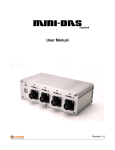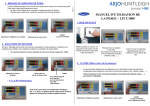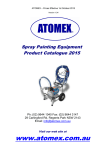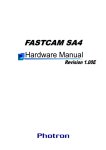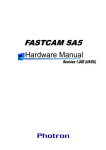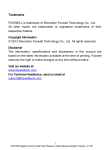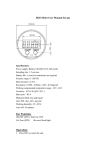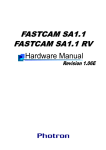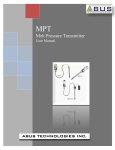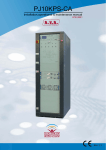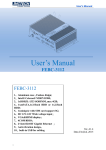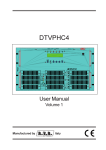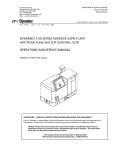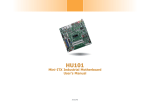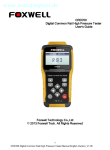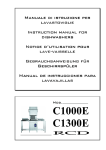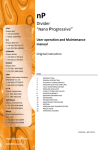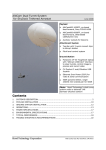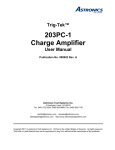Download PRESSURE SENSORS FOR HIGH TEMPERATURE
Transcript
PRESSURE SENSORS FOR HIGH TEMPERATURE User’s Manual Code 85184C - Edition 04 - 07/2010 85184C - User’s Manual – Pressure Sensors for high temperature 2 85184C - User’s Manual – Pressure Sensors for high temperature INDEX 1. GENERAL INFORMATION ............................................................................................................................................. 4 1.1 General information .................................................................................................................................................. 4 1.2 Copyright ......................................................................................................... Errore. Il segnalibro non è definito. 1.3 Correct use ...................................................................................................... Errore. Il segnalibro non è definito. 2. MELT SENSOR AND THE MODELS ..................................................................... Errore. Il segnalibro non è definito. 2.1 Melt Sensor ..................................................................................................... Errore. Il segnalibro non è definito. 2.2 Models ...................................................................................................................................................................... 5 3. TECHNICAL DATA ......................................................................................................................................................... 7 4. WEIGHT AND MECHANICAL DIMENSIONS ............................................................................................................... 24 4.1 Weight .................................................................................................................................................................... 24 4.2 Specific filling liquid ................................................................................................................................................ 24 4.3 Mechanical dimensions .......................................................................................................................................... 24 5.1 Instruction and maintenance (Installation hole) ...................................................................................................... 25 5.2 Instruction and maintenance (Sensor installation procedure) ................................................................................. 27 5.3 Instruction and maintenance (Mechanical dimensions of transducer / drilling) ....................................................... 28 6. INSTALLATION AND ELECTRICAL CONNECTIONS .................................................................................................. 29 6.1 General precautions ............................................................................................................................................... 29 6.2 Transmitters with digital output ............................................................................................................................... 29 6.3 Transmitters with amplified analog output .............................................................................................................. 30 6.4 Transducers with non-amplified analog output ....................................................................................................... 33 6.5 Protection for outdoor installations of analog sensors ............................................................................................ 34 6.6 Standard reference ................................................................................................................................................. 35 6.7 EMC and RoHS Requisites .................................................................................................................................... 36 7. ON-BOARD FUNCTION ............................................................................................................................................... 37 7.1 Autozero function.................................................................................................................................................... 37 7.2 Fine-Autozero function ........................................................................................................................................... 38 7.3 Calibration function ................................................................................................................................................. 38 7.4 Autospan ................................................................................................................................................................ 39 7.5 Partial reset of the calibration values ...................................................................................................................... 39 7.6 Total reset of the calibration values ........................................................................................................................ 39 8. AUTOCOMPENSATION FUNCTION ............................................................................................................................ 40 8.1 Output signal trend as a function of temperature effect .......................................................................................... 40 9. MAINTENANCE ............................................................................................................................................................ 41 9.1 Maintenance ........................................................................................................................................................... 41 9.2 Transport, storage and disposal ...................................................................... Errore. Il segnalibro non è definito. 10. SAFETY ............................................................................................................... Errore. Il segnalibro non è definito. 11. CERTIFICATIONS ...................................................................................................................................................... 44 12. RESOLUTION PROBLEMS ........................................................................................................................................ 51 13. APPENDIX A: OPERATING PRINCIPLE .................................................................................................................... 52 13.1 Mechanical construction and operation ................................................................................................................ 52 13.2 Strain gauge ......................................................................................................................................................... 52 14. APPENDIX B: IP PROTECTION ................................................................................................................................. 54 15. APPENDIX C: GUIDE TO SELECTION OF THE DIAPHRAGM IN CONTACT WITH EXTRUDED POLYMER ......... 55 16. APPENDIX D: ACCURACY CLASS ............................................................................................................................ 56 16.1 Calibration curve................................................................................................................................................... 56 16.2 Repeatability ......................................................................................................................................................... 56 16.3 Hysteresis ............................................................................................................................................................. 57 16.4 Linearity ................................................................................................................................................................ 57 17. APPENDIX E: HAZARDOUS AREAS ......................................................................................................................... 59 17.1 Applications in hazardous areas ........................................................................................................................... 59 17.2 European Directive ATEX..................................................................................................................................... 60 17.3 North America Factory Mutual .............................................................................................................................. 62 18. APPENDIX F: MELT SENSORS WITH CANopen OUTPUT....................................................................................... 63 3 85184C - User’s Manual – Pressure Sensors for high temperature 1. GENERAL INFORMATION 1.1 General information This manual refers to the following products: M3, ME, MN, MX, MX4, MF, MD, M5, M6, W3, WE, WN, WX, WF, WD, W6, K3, KE, KN, KD and must be kept near the equipment for easy reading and consultation. It must be read, understood, and strictly follow in order to avoid and prevent accidents and/or malfunctions. Gefran will not be liable for any injury to people and/or damage to property deriving from disregard of this manual. 1.2 Copyright Any re production of this document, even partial or for internal use, requires Gefran’s approval. 1.3 Correct use Gefran Melt pressure sensors with amplified or non-amplified electrical output are designed and built to measure the pressure and temperature variable of melted plastic at different temperatures according to the filling fluid used. The correct temperature range is: • Up to 315°C, for W sensors series • Up to 400°C, for M sensors series • Up to 538°C, for K sensors series If the sensors are used as a safety component in accordante with the Machinery Directive, the equipment builder must take all necessary precautions to ensure that any malfunctions of the Melt pressure sensor do not injury to people and/or damage to property. 2. MELT SENSOR AND THE MODELS 2.1 Melt Sensor Gefran Melt sensors are pressure/temperature transducers and transmitters designed for use in high-temperature environments. They read media pressure up to a temperature of 538°C, and resist such high temperatures thanks to the ir special mechanical construction, in which the measurement element is isolated from the Melt. The constructive principle is based on hydraulic transmission of pressure; mechanical strain is transferred by means of a non-compressible transmission liquid. The liquid used in these sensors may be mercury (series M), FDA-approved oil (series W) or NaK (series K). Strain gauge technology translates the physical quantity (pressure) into an electrical signal. Four different designs are available: rigid rod, flexible sheathing, flexible plus thermocouple, and exposed tip. Gefran Melt sensors satisfy all installation and field requirements. The sensors can read an extremely wide range of pressures: from a version with minimum range of 0-17 bar up to a version with a scale of 0-2000 bar. All models in the catalog can be supplied in two different classes of accuracy: class M, with accuracy of 0.5% FSO, and class H, with accuracy of 0.25% FSO. mV/V, 4-20mA, 0-10V, 0-5V, and CANopen output signals, and Atex and Factory Mutual versions complete the packet of solutions available for all architectures now utilized for plastics processing machines. 4 85184C - User’s Manual – Pressure Sensors for high temperature 2.2 Models 3.33mV/V OUTPUT Rigid stem M30 (mercury) W30 (oil) K30 (NaK) Flexible stem M31 (mercury) W31 (oil) K31 (NaK) Flexible stem+Thermocouple M32 (mercury) W32 (oil) K32 (NaK) Exposed tip M33 (mercury) W33 (oil) K33 (NaK) 4-20mA CURRENT OUTPUT Rigid stem Flexible stem ME0 (mercury) ME1 (mercury) WE0 (oil) WE1 (oil) KE0 (NaK) KE1 (NaK) Flexible stem+Thermocouple ME2 (mercury) WE2 (oil) KE2 (NaK) Exposed tip ME3 (mercury) WE3 (oil) KE3 (NaK) 0-10V VOLTAGE OUTPUT Rigid stem MN0 (mercury) WN0 (oil) KN0 (NaK) Flexible stem MN1 (mercury) WN1 (oil) KN1 (NaK) Flexible stem+Thermocouple MN2 (mercury) WN2 (oil) KN2 (NaK) Exposed tip MN3 (mercury) WN3 (oil) KN3 (NaK) DIGITAL OUTPUT CANopen DP404 Rigid stem Flexible stem MD0 (mercury) MD1 (mercury) WD0 (oil) WD1 (oil) KD0 (NaK) KD1 (NaK) Flexible stem+Thermocouple MD2 (mercury) WD2 (oil) KD2 (NaK) Exposed tip MD3 (mercury) WD3 (oil) KD3 (NaK) GAUGE OUTPUT – ANALOG DISPLAY Rigid stem Flexible stem M50 (mercury) M51 (mercury) Flexible stem + Thermocouple M52 (mercury) 5 85184C - User’s Manual – Pressure Sensors for high temperature GAUGE OUTPUT – DIGITAL DISPLAY – RETRANSMISSION 4-20mA Rigid stem Flexible stem M60 (mercury) M61 (mercury) W60 (oil) W61 (oil) Rigid stem MX0 (mercury) WX0 (oil) (ATEX Certification) Intrinsic Safety protection – 4-20mA electrical current output Flexible stem Flexible stem + Thermocouple MX1 (mercury) MX2 (mercury) WX1 (oil) WX2 (oil) Exposed tip MX3 (mercury) WX3 (oil) Rigid stem MF0 (mercury) WF0 (oil) Flange stem MX4 (mercury) (FACTORY MUTUAL Certification) Explosionproof protection – 4-20mA electrical current output Flexible stem MF1 (mercury) WF1 (oil) Flexible stem + Thermocouple MF2 (mercury) WF2 (oil) 6 Flexible stem + Thermocouple M62 (mercury) W62 (oil) Exposed tip MF3 (mercury) WF3 (oil) 85184C - User’s Manual – Pressure Sensors for high temperature 3. TECHNICAL DATA MELT PRESSURE TRANSDUCERS M30/M31/M32/M33 series Main features Pressure range: from 0-35 to 0-2000 bar / from 0-500 to 0-30000 psi Accuracy: < ±0.25% FSO (H); < ±0.5% FSO (M) Fluid-filled system for temperature stability 3 3 Mercury filling volume: M30 series (30mm ) - M31/M32/M33 series (40mm ) 1/2-20UNF, M18x1.5 standard threads, other types available on request Standard diaphragm is 15-5PH stainless steel with GTP coating 17-7PH corrugated diaphragm with GTP coating for ranges below 100bar (1500psi) Accuracy (1) Resolution Measurement range Maximum overpressure Measurement principle Power supply Strain gauge bridge resistance Isolation resistance (at 50Vdc) Full Scale Output (FSO) (tollerance ±0.5%FSO) Zero balance Calibration signal Compensated temperature range Maximum temperature range Thermal drift in compensated range: Zero/Calibration/Sensibility Diaphragm maximum temperature Zero drift due to change in process temperature Standard material in contact with process medium Thermocouple (M32 model) Protection degree (6-pole connector) Electrical connections H < ±0.25% FSO (100…2000 bar) M < ±0.5% FSO (35…2000 bar) Infinite from 0…35 to 0…2000 bar (from 0…500 to 0…30000 psi) 2 x FS 1.5 x FS above 1000bar/15000psi Extensimetric 6…12Vdc (10Vdc typical) 350 Ohm (550 Ohm below 100bar/1500psi) > 1000 MOhm 2.5mV/V (option 2) 3.33 mV/V (option 3) ±0.5%FSO 80%FSO 0…+100°C / 32…212°F -30…+120°C / -22…+250°F < 0.02% FSO/°C < 0.01% FSO/°F 400°C / 750°F 0.02bar/°C 15psi/100°F Diaphragm: 15-5PH with GTP coating 17-7PH corrugated diaphragm with GTP coating for ranges < 100bar (1500psi) Stem: 17-4PH STD: type “J” (isolated junction) IP65 6-pin connector VPT07RA10-6PT (PT02A-10-6P) 8-pin connector PC02E-12-8P FSO = Full Scale Output (1) BFSL method (Best Fit Straight Line): includes combined effects of Non-Linearity, Hysteresis and Repeatability. According to the European Directive 97/23/CE (PED), for range above 500bar the M3…/M2… series declare the CE mark. 7 85184C - User’s Manual – Pressure Sensors for high temperature MELT PRESSURE TRANSDUCERS ME0/ME1/ME2/ME3 series Main features Pressure ranges: from 0-35 to 0-2000 bar / from 0-500 to 0-30000 psi Accuracy: < ±0.25% FSO (H); < ±0.5% FSO (M) Fluid-filled system for temperature stability 3 3 Mercury filled volume: ME0 series (30mm ) - ME1/ME2/ME3 series (40mm ) 1/2-20UNF, M18x1.5 standard threads, other types availbale on request Other diaphragms available on request Autozero function on board / external option Drift Autocompensation function (SP version) Standard diaphragm is 15-5PH stainless steel with GTP coating 17-7PH corrugated diaphragm with GTP coating for ranges below 100bar (1500psi) Accuracy (1) Resolution Measurement range Maximum overpressure Measurement principle Power supply Maximum current absorption Insulation resistance (at 50Vdc) Output signal Full Scale (FSO) Zero balance (tollerance ±0.25% FSO) Zero signals adjustment (tollerance ±0.25% FSO) Span adjustment within ±5% FSO Maximum allowed load Response time (10…90% FSO) Output noise (RMS 10-400Hz) Calibration signal Output short circuit ingress and reverse polarity protection Compensated temperature range Operating temperature range Storage temperature range Thermal drift in compensated range: Zero/Calibration/Sensibility Diaphragm maximum temperature Zero drift due to change in process temperature (zero) Zero drift temperature for Autocompensated version (SP) within the temperature range 20°C-400°C inclusive t he drift temperature of the housing Standard materialin contact with process medium Thermocouple (ME2 model) Protection degree (6-pole female connector) H < ±0.25% FSO (100…2000 bar) M < ±0.5% FSO (35…2000 bar) Infinite from 0…35 to 0…2000 bar (from 0…500 to 0…30000 psi) 2 x FS 1.5 x FS above 1000bar/15000psi Extensimetric 10-30Vdc 32mA > 1000 MOhm 20mA 4mA “Autozero” function See Manual See diagram ~1ms < 0.025% FSO 80% FSO YES 0…+85°C -30…+105°C -40…+125°C < 0.02% FSO/°C 400°C / 750°F < 0.02 bar/°C < 0.003 bar/°C 100 ≤ p < 500 bar 0.0014% FS/°C p ≥ 500 bar Diaphragm: 15-5PH with GTP coating 17-7PH corrugated diaphragm with GTP coating for ranges < 100bar (1500psi) Stem: 17-4PH STD: type “J” (isolated junction) IP65 FSO = Full Scale Output (1) BFSL method (Best Fit Straight Line): includes combined effects of Non-Linearity, Hysteresis and Repeatability. 8 85184C - User’s Manual – Pressure Sensors for high temperature MELT PRESSURE TRANSDUCERS MN0/MN1/MN2/MN3 series Main features Pressure ranges: from 0-35 to 0-2000 bar / from 0-500 to 0-30000 psi Accuracy: < ±0.25% FSO (H); < ±0.5% FSO (M) Fluid-filled system for temperature stability 3 3 Mercury filling volume: MN0 series (30mm ) - MN1/MN2/MN3 series (40mm ) 1/2-20UNF, M18x1.5 standard threads, other types available on request Other diaphragms available on request Autozero function on board / external option Drift Autocompensation function (SP version) Standard diaphragm is 15-5PH stainless steel with GTP coating 17-7PH corrugated diaphragm with GTP coating for ranges below 100bar (1500psi) Accuracy (1) Resolution Measurement range Maximum overpressure Measurement principle Power supply Maximum current absorption Insulation resistance (at 50Vdc) Output signal Full Scale (FSO) Zero balance (tollerance ±0.25% FSO) Zero signals adjustment (tollerance ±0.25% FSO) Span adjustment within ±5% FSO Maximum allowed load Response time (10…90% FSO) Output noise (RMS 10-400Hz) Calibration signal Output short circuit ingress and reverse polarity protection Compensated temperature range Operating temperature range Storage temperature range Thermal drift in compensated range: Zero/Calibration/Sensibility Diaphragm maximum temperature Zero drift due to change in process temperature (zero) Zero drift temperature for Autocompensated version (SP) within the temperature range 20°C-400°C inclusive t he drift temperature of the housing Standard material in contact with process medium Thermocouple (MN2 model) Protection degree (6-pole female connector) H < ±0.25% FSO (100…2000 bar) M < ±0.5% FSO (35…2000 bar) Infinite from 0…35 to 0…2000 bar (from 0…500 to 0…30000 psi) 2 x FS 1.5 x FS above 1000bar/15000psi Extensimetric 15...30Vdc (N, C) 10...30Vdc (B, M) -15...+15Vdc (H, L) 25mA > 1000 MOhm 5Vdc (M, H) - 10Vdc (N,L) - 5,1Vdc (B) - 10,1Vdc (C) 0Vdc (M, N, H, L) - 0,1Vdc (B, C) “Autozero” function See Manual 1 mA ~1ms < 0.025% FSO 80% FSO YES 0…+85°C -30…+105°C -40…+125°C < 0.02% FSO/°C 400°C / 750°F < 0.02 bar/°C < 0.003 bar/°C 100 ≤ p < 500 bar 0.0014% FS/°C p ≥ 500 bar Diaphragm: 15-5PH with GTP coating 17-7PH corrugated diaphragm with GTP coating for ranges < 100bar (1500psi) Stem: 17-4PH STD: type “J” (isolated junction) IP65 FSO = Full Scale Output (1) BFSL method (Best Fit Straight Line): includes combined effects of Non-Linearity, Hysteresis and Repeatability. 9 85184C - User’s Manual – Pressure Sensors for high temperature MELT PRESSURE TRANSMITTERS MD0/MD1/MD2/MD3 series Main features Pressure ranges: from 0-35 to 0-2000 bar / from 0-500 to 0-30000 psi Accuracy: < ±0.25% FSO (H); < ±0.5% FSO (M) Hydraulic transmission system to guarantee temperature stability (Hg) 3 3 Quantity of Hg contained for model: series MD0 (30mm ) - MD1/MD2/MD3 (40mm ) Standard threading 1/2-20UNF, M18x1.5, other versions on request Autozero function on board / external option Drift Autocompensation function (SP version) Stainless steel 15-5PH diaphragm with GTP coating For ranges below 100bar (1500psi): stainless steel 17-7PH corrugated diaphragm with GTP coating Rated precision, including effects of Linearity, Repeatability and Hysteresis Sampling Pressure ranges Maximum applicable pressure Measurement principle Power supply Typical input Insulation resistance (at 50Vdc) Signal at rated pressure (FSO) Signal at ambient pressure Calibration of ambient pressure Signal protocol Response time (10…90% FSO) Calibration signal Protection against overvoltage and reverse polarity of power supply Compensated temperature range of strain Gauge Housing Maximum temperature range of strain Gauge Housing Thermal drift in compensated range: Zero Calibration Sensitivity Max. diaphragm temperature Influence due to variation of fluid temperature (Zero) Standard material in contact with process medium Thermocouple (MD2 model) Protection level Electrical connections H < ±0.25% FSO (100…2000 bar) M < ±0.5% FSO (35…2000 bar) 16 bit (1) from 0…35 to 0…2000bar (from 0…500 to 0…30000psi) 2 x FSO Strain gauge 12...40Vdc 40mA (2) > 1000 MOhm Depends on FSO 0 Insertion o fan offset DP404 CANopen, with baud rate selectable from 10K to 1Mbaud (default 500Kbaud) 20ms 80% FSO YES 0…+76°C (32…170°F) -30…+85°C ( -22…+185°F) < 0.02% FSO/°C < 0.01%FSO/°F < 0.01%FSO/°F 400°C (750°F) < 0.02 bar/°C (15 psi/100°F) Diaphragm: 15-5PH with GTP coating 17-7PH corrugated diaphragm with GTP coating for ranges < 100bar (1500psi) Stem: 17-4PH STD: type “J” (isolated coupling) IP65 M12, DIN EN 50044 5-pin connector FSO = Full Scale Output (signal at rated pressure) (1) Resolution: 0,01bar from 35…500bar, 0,1bar from 700…2000bar 0,1psi from 5000…350psi, 1psi from 7500…30000psi (2) Conditions: Power supply 24Vdc 10 85184C - User’s Manual – Pressure Sensors for high temperature MELT PRESSURE TRANSMITTERS FOR APPLICATIONS IN POTENTIALLY EXPLOSIVE ATMOSPHERES MX0/MX1/MX2/MX3 series Main features Pressure ranges: from 0-35 to 0-2000 bar / from 0-500 to 0-30000 psi Extensimetric measurement principle with Wheatstone bridge Accuracy: < ±0.25% FSO (H); < ±0.5% FSO (M) Calibration signal 80% FSO internally generated Completely interchangeable with all existing products Protection level: IP65 (6-pin connector) Standard threading 1/2-20UNF, M18x1.5, other versions on request Stainless steel diaphragm 15-5PH with GTP coating For ranges below 100bar (1500psi): 17-7PH corrugated stainless steel diaphragm with GTP coating Other diaphragm types available on request Rated precision, including effects of Linearity, Repeatability and Hysteresis Resolution Pressure ranges Maximum applicable pressure Principle of measurement Power supply Maximum input Isolation resistance (at 50Vdc) Signal at rated pressure (FSO) Zero balancing Calibration: Rated pressure Room pressure Maximum load Response time (10…90% FSO) Output noise (RMS 10-400Hz) Calibration signal Protection against overvoltages and power supply polarity reverse Temperature range of strain Gauge Housing Thermal drift compensated range: Zero/Calibration/Sensitivity Maximum temperature of diaphragm Influence due to fluid temperature change (Zero) Standard material in contact with process medium Thermocouple (MX2 model) Protection level (with 6-pin female connector installed) Electrical connections H < ±0.25% FSO (100…2000 bar) M < ±0.5% FSO (35…2000 bar) Infinite from 0…35 to 0…2000bar (from 0…500 to 0…30000psi) 2 x FS 1,5 x FS beyond 1000bar/15000psi Strain gauge 12...30Vdc 30mA > 1000 MOhm 20mA 4mA 5%FSO min. 10bar (150psi) See diagram ~4ms < 0.05% FSO 80% FSO YES -20…+70°C ( -4…+158°F) < 0.02% FSO/°C (< 0.01% FSO/°F) 400°C (750°F) < 0.02 bar/°C (15 psi/100°F) Diaphragm: 15-5PH with GTP coating 17-7PH corrugated diaphragm with GTP coating for ranges < 100bar (1500psi) Stem: 17-4PH STD: type “J” (isolated junction) IP65 VPT07RA10-6PT (PT02A-10-6P) 6-pin connector PC02E-12-8P 8-pin connector FSO = Full Scale Output (signal at rated pressure) 11 85184C - User’s Manual – Pressure Sensors for high temperature FLANGE STEM MOUNT MELT PRESSURE TRANSMITTERS FOR APPLICATIONS IN POTENTIALLY EXPLOSIVE MX4 series Main features Pressure ranges: from 0-25 to 0-2000 bar / from 0-360 to 0-30000 psi Extensimetric measurement principle with Wheatstone bridge Accuracy: < ±0.25% FSO (H); < ±0.5% FSO (M) Calibration signal 80% FSO internally generated Completely interchangeable with all existing products Protection level: IP65 (6-pin connector) Flange mounting Stainless steel diaphragm 15-5PH with GTP coating For ranges below 100bar (1500psi): corrugated stainless steel diaphragm with GTP coating Other diaphragm types available on request Rated precision, including effects of Linearity, Repeatability and Hysteresis Resolution Pressure ranges Maximum applicable pressure Principle of measurement Power supply Maximum input Isolation resistance (at 50Vdc) Signal at rated pressure (FSO) Zero balancing Calibration: Rated pressure Room pressure Maximum load Response time (10…90% FSO) Output noise (RMS 10-400Hz) Calibration signal Protection against overvoltages and power supply polarity reverse Temperature range of strain Gauge Housing Thermal drift in compensated range: Zero/Calibration/Sensitivity Maximum temperature of diaphragm Influence due to fluid temperature change (Zero) Standard material in contact with process medium Sealing Protection level (with 6-pin female connector installed) Electrical connections FSO = Full Scale Output (signal at rated pressure) 12 H < ±0.25% FSO (100…2000 bar) M < ±0.5% FSO (25…2000 bar) Infinite from 0…25 to 0…2000bar (from 0…360 to 0…30000psi) 2 x FS 1,5 x FS beyond 1000bar/15000psi Strain gauge 12...30Vdc 30mA > 1000 MOhm 20mA 4mA 5%FSO min. 10bar (150psi) See diagram ~4ms < 0.05% FSO 80% FSO YES -20…+70°C ( -4…+158°F) < 0.02% FSO/°C (< 0.01% FSO/°F) 400°C (750°F) < 0.02 bar/°C (15 psi/100°F) Diaphragm: 15-5PH with GTP coating 17-7PH corrugated diaphragm with GTP coating for ranges < 100bar (1500psi) Stem: 17-4PH Copper washer silver plated IP65 VPT07RA10-6PT (PT02A-10-6P) 6-pin connector PC02E-12-8P 8-pin connector 85184C - User’s Manual – Pressure Sensors for high temperature EXPLOSIONPROOF MELT PRESSURE TRANSMITTER MF series Main features Factory Mutual approved Explosionproof for Class I, Division 1, Groups A, B, C, D and Dust-Ignitionproof for Class II, Division 1, Groups E, F, G Other approvals: CE, NEMA 4/IP65 High-level output 2-wire, 4-20mA Accuracy: < ±0.25% FSO (H); < ±0.5% FSO (M) Calibration signal 80% FSO internally generated (R-Cal) Standard threading 1/2-20UNF, M18x1.5 also available Fluid-filled system for temperature stability 15-5PH stainless steel diaphragm with Armoloy coating standard 17-7PH corrugated diaphragm with TiN (Titanium Nitride) coating for ranges below (1500psi) Other diaphragm available on request Rated precision, including effects of Linearity, Repeatability and Hysteresis Resolution Measurement range Maximum overpressure Measurement principle Power supply Maximum current consumption Isolation resistance (at 50Vdc) Signal at rated pressure (FSO) Zero balance Calibration: Rated pressure Room pressure Response time (10…90% FSO) Output noise (RMS 10-400Hz) Calibration signal Protection against output short circuit and supply voltage inverted polarity Protection against output voltage spikes Strain gauge housing compensated temperature range Housing temperature range Thermal drift in compensated range (*): Zero Sensitivity Maximum diaphragm temperature Maximum zero drift due to change in process temperature Material in contact with process medium Standard Below 100bar (1500psi) H < ±0.25% FSO for ranges 100bar (1500psi) M < ±0.5% FSO for ranges 100bar (1500psi) Infinite from 0…35 to 0…2000bar (from 0…500 to 0…30000psi) 2 x FSO (1000bar [15000psi]) 1,5 x FSO (1000bar [15000psi]) Strain gauge with Wheatstone bridge 12...30Vdc (24Vdc rec.) 20mA > 1000 MOhm 20mA 4mA 5%FSO min. 10bar (150psi) ~8ms < 0.05% FSO 80% FSO YES YES (according to 89/336/EEC) from 0°C to 76°C (from 32°F to 170°F) -30…+85°C ( -22…+185°F) 2.0%/100°C (1.0%/100°F) 2.0%/100°C (1.0%/100°F) 400°C (750°F) < 0.02 bar/°C (15 psi/100°F) 15-5PH SS (Armoloy coated) 17-7PH SS corrugated (Titanium Nitride coated) FSO = Full Scale Output (signal at rated pressure) (*) For ranges below 70bar (1000psi), zero and sensitivity shift are 6.0%/100°C (3.0%/100°F) 13 85184C - User’s Manual – Pressure Sensors for high temperature OIL-FILLED MELT PRESSURE TRANSDUCERS W30/W31/W32/W33 series Main features Pressure ranges: from 0-35 to 0-1000 bar / from 0-500 to 0-15000 psi Accuracy: < ±0.25% FSO (H); < ±0.5% FSO (M) Fluid-filled system for temperature stability Oil filling meets FDA requirements CFR 178.3620 and CFR 172.878 3 3 Oil filling volume: W30 series (30mm ) - W31/W32/W33 series (40mm ) 1/2-20UNF, M18x1.5 standard threads, other types available on request Standard diaphragm is a 17-7PH stainless steel GTP coating corrugated diaphragm Accuracy (1) Resolution Measurement range Maximum overpressure Measurement principle Power supply Strain gauge bridge resistance Isolation resistance (at 50Vdc) Full Scale Output (tollerance ±0.5%FSO) Zero balance Calibration signal Compensated temperature range Maximum temperature range Thermal drift in compensated range: Zero/Calibration/Sensibility Diaphragm maximum temperature Zero drift due to change in process temperature Standard material in contact with process medium Thermocouple (W32 model) Protection degree (6-pole connector) Electrical connections H < ±0.25% FSO (100…2000 bar) M < ±0.5% FSO (35…2000 bar) Infinite from 0…35 to 0…1000 bar (from 0…500 to 0…15000 psi) 2 x FS 1.5 x FS above 500bar/7500psi Extensimetric 6…12Vdc (10Vdc typical) 350 Ohm (550 Ohm below 100bar/1500psi) > 1000 MOhm 2.5mV/V (option 2) 3.33 mV/V (option 3) ±0.5% 80%FSO 0…+100°C / 32…212°F -30…+120°C / -22…+250°F < 0.02% FSO/°C < 0.01% FSO/°F 315°C / 600°F 0.04bar/°C 15psi/100°F Diaphragm: 17-7PH corrugated diaphragm with GTP coating Stem: 17-4PH STD: type “J” (isolated junction) IP65 6-pin connector VPT07RA10-6PT (PT02A-10-6P) 8-pin connector PC02E-12-8P FSO = Full Scale Output (1) BFSL method (Best Fit Straight Line): includes combined effects of Non-Linearity, Hysteresis and Repeatability. 14 85184C - User’s Manual – Pressure Sensors for high temperature OIL-FILLED MELT PRESSURE TRANSDUCERS WE0/WE1/WE2/WE3 series Main features Pressure ranges: from 0-35 to 0-1000 bar / from 0-500 to 0-15000 psi Accuracy: < ±0.25% FSO (H); < ±0.5% FSO (M) Fluid-filled system for temperature stability Oil filling meets FDA requirements CFR 178.3620 and CFR 172.878 3 3 Oil filling volume: WE0 series (30mm ) - WE1/WE2/WE3 series (40mm ) 1/2-20UNF, M18x1.5 standard threads, other types available on request Other diaphragms available on request Autozero function on board / external option Drift Autocompensation function (SP version) 17-7PH corrugated diaphragm with GTP coating Accuracy (1) Resolution Measurement range Maximum overpressure Measurement principle Power supply Maximum current absorption Insulation resistance (at 50Vdc) Output signal Full Scale (FSO) Zero balance (tollerance ±0.25% FSO) Zero signals adjustment (tollerance ±0.25% FSO) Span adjustment within ±5% FSO Maximum allowed load Response time (10…90% FSO) Output noise (RMS 10-400Hz) Calibration signal Output short circuit ingress and reverse polarity protection Compensated temperature range Operating temperature range Storage temperature range Thermal drift in compensated range: Zero/Calibration/Sensibility Diaphragm maximum temperature Zero drift due to change in process temperature (zero) Zero drift temperature for Autocompensated version (SP) within the temperature range 20°C-315°C inclusive t he drift temperature of the housing Standard material in contact with process medium Thermocouple (WE2 model) Protection degree (6-pole female connector) H < ±0.25% FSO (100…1000 bar) M < ±0.5% FSO (35…1000 bar) Infinite from 0…35 to 0…1000 bar (from 0…500 to 0…15000 psi) 2 x FS 1.5 x FS above 500bar/7500psi Extensimetric 10...30Vdc 32mA > 1000 MOhm 20mA 4mA “Autozero” function See Manual See diagram ~1ms < 0.025% FSO 80% FSO YES 0…+85°C -30…+105°C -40…+125°C < 0.02% FSO/°C 315°C / 600°F < 0.04 bar/°C < 0.005 bar/°C 100 ≤ p < 500 bar 0.0022% FS/°C p ≥ 500 bar Diaphragm: 17-7PH corrugated diaphragm with GTP coating Stem: 17-4PH STD: type “J” (isolated junction) IP65 FSO = Full Scale Output (1) BFSL method (Best Fit Straight Line): includes combined effects of Non-Linearity, Hysteresis and Repeatability. 15 85184C - User’s Manual – Pressure Sensors for high temperature OIL-FILLED MELT PRESSURE TRANSDUCERS WN0/WN1/WN2/WN3 series Main features Pressure ranges: from 0-35 to 0-1000 bar / from 0-500 to 0-15000 psi Accuracy: < ±0.25% FSO (H); < ±0.5% FSO (M) Fluid-filled system for temperature stability Oil filling meets FDA requirements CFR 178.3620 and CFR 172.878 3 3 Oil filling volume: WN0 series (30mm ) - WN1/WN2/WN3 series (40mm ) 1/2-20UNF, M18x1.5 standard threads, other types available on request Other diaphragms available on request Autozero function on board / external option Drift Autocompensation function (SP version) 17-7PH corrugated diaphragm with GTP coating Accuracy (1) Resolution Measurement range Maximum overpressure Measurement principle Power supply Maximum current absorption Insulation resistance (at 50Vdc) Output signal Full Scale (FSO) Zero balance (tollerance ±0.25% FSO) Zero signals adjustment (tollerance ±0.25% FSO) Span adjustment within ±5% FSO Maximum allowed load Response time(10…90% FSO) Output noise (RMS 10-400Hz) Calibration signal Output short circuit ingress and reverse polarity protection Compensated temperature range Operative temperature range Storage temperature range Thermal drift in compensated range: Zero/Calibration/Sensibility Diaphragm maximum temperature Zero drift due to change in process temperature (zero) Zero drift temperature for Autocompensated version (SP) within the temperature range 20°C-315°C inclusive t he drift temperature of the housing Standard material in contact with process medium Thermocouple (WN2 model) Protection degree (6-pole female connector) H < ±0.25% FSO (100…1000 bar) M < ±0.5% FSO (35…1000 bar) Infinite from 0…35 to 0…1000 bar (from 0…500 to 0…15000 psi) 2 x FS 1.5 x FS above 500bar/7500psi Extensimetric 15...30Vdc (N, C) 10...30Vdc (B, M) -15...+15Vdc (H, L) 25mA > 1000 MOhm 5Vdc (M, H) - 10Vdc (N, L) - 5,1Vdc (B) - 10,1Vdc (C) 0Vdc (M, N, H, L) - 0,1Vdc (B, C) “Autozero” function See Manual 1 mA ~1ms < 0.025% FSO 80% FSO YES 0…+85°C -30…+105°C -40…+125°C < 0.02% FSO/°C 315°C / 600°F < 0.04 bar/°C < 0.005 bar/°C 100 ≤ p < 500 bar 0.0022% FS/°C p ≥ 500 bar Diaphragm: 17-7PH corrugated diaphragm with GTP coating Stem: 17-4PH STD: type “J” (isolated junction) IP65 FSO = Full Scale Output (1) BFSL method (Best Fit Straight Line): includes combined effects of Non-Linearity, Hysteresis and Repeatability. 16 85184C - User’s Manual – Pressure Sensors for high temperature OIL-FILLED MELT PRESSURE TRANSMITTERS WD0/WD1/WD2/WD3 series Main features Pressure ranges: from 0-35 to 0-1000 bar / from 0-500 to 0-15000 psi Accuracy: < ±0.25% FSO (H); < ±0.5% FSO (M) Extensimetric measurement principle with Wheatstone bridge Hydraulic transmission system to guarantee temperature stability. Filling with certifyd oil FDA, CFR 178.3620 and CFR 172.878 3 3 Quantity of Oil contained for model: series WD0 (30mm ) - WD1/WD2/WD3 (40mm ) Standard threading 1/2-20UNF, M18x1.5, other versions on request Autozero function on board / external option Drift Autocompensation function (SP version) Stainless steel 17-7PH diaphragm with GTP coating Rated precision, including effects of Linearity, Repeatability and Hysteresis Sampling Pressare ranges Maximum applicable pressure Measurement principle Power supply Typical input Insulation resistance (at 50Vdc) Signal at rated pressure (FSO) Signal at ambient pressure Calibration of ambient pressure Signal protocol Response time (10…90% FSO) Calibration signal Protection against overvoltage and reverse polarity of power supply Compensated temperature range of strain Gauge Housing Maximum temperature range of strain Gauge Housing Thermal drift in compensated range: Zero Calibration Sensitivity Max. diaphragm temperature influente due to variation of fluid temperature (Zero) Standard material in contact with process medium Thermocouple (WD2 model) Protection level Electrical connections H < ±0.25% FSO (350…1000 bar) M < ±0.5% FSO (35…1000 bar) 16 bit (1) from 0…35 to 0…1000bar (from 0…500 to 0…15000psi) 2 x FSO Strain gauge 12...40Vdc 40mA (2) > 1000 MOhm Depends on FSO 0 Insertion of an offset DP404 CANopen, with baud rate selectable from 10K to 1Mbaud (default 500Kbaud) 20ms 80% FSO YES 0…+76°C (32…170°F) -30…+85°C ( -22…+185°F) < 0.02% FSO/°C < 0.01%FSO/°F < 0.01%FSO/°F 315°C (6 00°F) < 0.04 bar/°C (30 psi/100°F) Diaphragm: 17-7PH corrugated diaphragm with GTP Stem: 17-4PH STD: type “J” (isolated coupling) IP65 M12, DIN EN 50044 5-pin connector FSO = Full Scale Output (signal at rated pressure) (1) Resolution: 0,01bar from 35…500bar, 0,1bar from 700…1000bar 0,1psi from 5000…350psi, 1psi from 7500…15000psi (2) Conditions: Power supply 24Vdc 17 85184C - User’s Manual – Pressure Sensors for high temperature OIL FILLED MELT PRESSARE TRANSMITTERS FOR HAZARDOUS AREAS WX0/WX1/WX2/WX3 series Main features Pressare ranges: from 0-35 to 0-1000 bar / from 0-500 to 0-15000 psi Extensimetric measurement principle with Wheatstone bridge Accuracy: < ±0.25% FSO (H); < ±0.5% FSO (M) Calibration signal 80% FSO internally generated Filling with FDA approved oil CFR 178.3620 and CFR 178.878 Completely interchangeable with all existing products Protection level: IP65 (6-pin connector) Standard threading 1/2-20UNF, M18x1.5, other versione on request Stainless steel 17-7PH diaphragm with GTP coating Rated precision, including effects of Linearity, Repeatability and Hysteresis Resolution Pressare ranges Maximum applicable pressure Principle of measurement Power supply Maximum input Isolation resistance (at 50Vdc) Signal at rated pressure (FSO) Zero balance Calibration: Rated pressure Room pressure Maximum load Response time (10…90% FSO) Output noise (RMS 10-400Hz) Calibration signal Protection against overvoltages and power supplì polarità reverse Protection against pulses injected on output Temperature ranger of strain Gauge Housing Thermal drift in compensated range: Zero/Calibration/Sensitivity Maximum temperature of diaphragm Influente due to fluid temperature change (Zero) Standard material in contact with process medium Thermocouple (WX2 model) Protection level (with 6-pin female connector installed) Electrical connections FSO = Full Scale Output (signal at rated pressure) 18 H < ±0.25% FSO (350…1000 bar) M < ±0.5% FSO (35…1000 bar) Infinite from 0…35 to 0…1000bar (from 0…500 to 0…15000psi) 2 x FS 1,5 x FS above 500bar/7500psi Strain gauge 12...30Vdc 30mA > 1000 MOhm 20mA 4mA 5%FSO min. 10bar (150psi) See diagram ~4ms < 0.05% FSO 80% FSO YES YES (in compliance with 89/336/EEC) -20…+70°C ( -4…+158°F) < 0.02% FSO/°C (< 0.01% FSO/°F) 315°C (600°F) < 0.04 bar/°C (30 psi/100°F) Diaphragm: 17-7PH corrugated diaphragm with GTP coating Stem: 17-4PH STD: type “J” (isolated junction) IP65 VPT07RA10-6PT (PT02A-10-6P) 6-pin connector PC02E-12-8P 8-pin connector 85184C - User’s Manual – Pressure Sensors for high temperature EXPLOSIONPROOF MELT PRESSARE TRANSMITTER (OIL-FILLED) WF series Main features Factory Mutual approved Explosionproof for Class I, Division 1, Groups A, B, C, D and Dust-Ignitionproof for Class II, Division 1, Groups E, F, G Other approvals: CE, NEMA 4/IP65 High-level output 2-wires, 4-20mA Accuracy: < ±0.25% FSO (H); < ±0.5% FSO (M) Calibration signal 80% FSO internally generated (R-Cal) Standard threading 1/2-20UNF, M18x1.5 also available Fluid-filled system for temperature stability 17-7PH corrugated diaphragm with TiN (Titanium Nitride) coating standard Oil-fill is FDA approved. Meets requirements CFR 172.3620 and CFR 172.878 Rated precision, including effects of Linearity, Repeatability and Hysteresis Resolution Measurement range Maximum overpressure Measurement principle Power supply Maximum current consumption Isolation resistance (at 50Vdc) Full Scale Output (FSO) Zero balance Calibration: Nominal pressure Room pressure Response time (10…90% FSO) Output noise (RMS 10-400Hz) Calibration signal Protection against output signal circuit and supplì voltage inverted polarity Protection against output voltage spikes Compensated temperature range of strain Gauge Housing Housing temperature range Thermal drift in compensated range (*): Zero Sensitivity Maximum diaphragm temperature Maximum Zero drift due to ch’ange in process temperature Material in contact with process medium H < ±0.25% FSO for ranges 100bar (1500psi) M < ±0.5% FSO for ranges 100bar (1500psi) Infinite from 0…35 to 0…2000bar (from 0…500 to 0…30000psi) 2 x FSO (1000bar [15000psi]) 1,5 x FSO (1000bar [15000psi]) Strain gauge with Wheatstone bridge 12...30Vdc (24Vdc rec.) 20mA > 1000 MOhm 20mA 4mA 5%FSO min. 10bar (150psi) ~8ms < 0.05% FSO 80% FSO YES YES (accordino to 89/336/EEC) from 0°C to 76°C (from 32°F to 170°F) -30…+85°C ( -22…+185°F) 2.0%/100°C (1.0%/100°F) 2.0%/100°C (1.0%/100°F) 315°C (600°F) < 0.02 bar/°C (15 psi/100°F) 17-7PH SS corrugated (Titanium Nitride coated) FSO = Full Scale Output (signal at rated pressure) (*) For ranges below 70bar (1000psi), zero and sensitivity shift are 6.0%/100°C (3.0%/100°F) 19 85184C - User’s Manual – Pressure Sensors for high temperature MELT PRESSURE TRANSDUCERS K30/K31/K32/K33 series Main features Pressure ranges: from 0-35 to 0-1000 bar / from 0-500 to 0-15000 psi Accuracy: < ±0.25% FSO (H); < ±0.5% FSO (M) Hydraulic transmission system for pressure signal guarantees stability at working temperature (NaK). Liquid conforming to RoHS Directive. NaK is defined as a safe substance (GRAS) 3 3 3 3 Quantity of NaK contained: K30 series (30mm ) [0,00183 in ] - K31/K32/K33 series (40mm ) [0,00244 in ] 1/2-20UNF, M18x1.5 standard threads, other types available on request Inconel 718 diaphragm with GTP coating for temperatures up to 538°C (1000°F) 15-5PH diaphragm with GTP coating for temperatures up to 400°C (750°F) Hastelloy C276 diaphragm for temperatures up to 300°C (570°F) 17-7PH corrugated diaphragm with GTP coating for ranges below 100bar (1500psi) Stem material: 17-4PH Accuracy (1) Resolution Measurement range Maximum overpressure Measurement principle Power supply Bridge resistance Insulation resistance (at 50Vdc) Output signal Full Scale (FSO) (tollerance ±0.5%FSO) Zero balance Calibration signal Compensated temperature range Maximum temperature range Thermal drift in compensated range: Zero/Calibration/Sensibility Diaphragm maximum temperature Zero drift due to change in process temperature (zero) Thermocouple (K32 model) Protection degree (with 6-pole female connector) Electrical connections H < ±0.25% FSO (100…1000 bar) M < ±0.5% FSO (35…1000 bar) Infinite from 0…35 to 0…1000 bar (from 0…500 to 0…15000 psi) 2 x FS 1.5 x FS over 1000bar/15000psi Extensimetric 6…12Vdc (10Vdc typical) 350 Ohm (550 Ohm below 100bar/1500psi) > 1000 MOhm 2.5mV/V (option 2) 3.33 mV/V (option 3) ±5% 80%FSO 0…+100°C / 32…212°F -30…+120°C / -22…+250°F < 0.02% FSO/°C < 0.01% FSO/°F 538°C / 1000°F < 3,5 bar/100°C < 28 psi/100°F STD: type “J” (isolated junction) IP65 6-pin connector VPT07RA10-6PT (PT02A-10-6P) 8-pin connector PC02E-12-8P FSO = Full Scale Output (1) BFSL method (Best Fit Straight Line): includes combined effects of Non-Linearity, Hysteresis and Repeatability. 20 85184C - User’s Manual – Pressure Sensors for high temperature MELT PRESSURE TRANSDUCERS KE0/KE1/KE2/KE3 series Main features Pressure ranges: from 0-35 to 0-1000 bar / from 0-500 to 0-15000 psi Accuracy: < ±0.25% FSO (H); < ±0.5% FSO (M) Hydraulic transmission system for pressure signal guarantees stability at working temperature (NaK). Liquid conforming to RoHS Directive. NaK is defined as a safe substance (GRAS) 3 3 3 3 Quantity of NaK contained: KE0 series (30mm ) [0,00183 in ] - KE1/KE2/KE3 series (40mm ) [0,00244 in ] 1/2-20UNF, M18x1.5 standard threads, other types available on request Autozero function on board / external option Stem drift Autocompensation function (SP version) Inconel 718 diaphragm with GTP coating for temperatures up to 538°C (1000°F) 15-5PH diaphragm with GTP coating for temperatures up to 400°C (750°F) Hastelloy C276 diaphragm for temperatures up to 300°C (570°F) 17-7PH corrugated diaphragm with GTP coating for ranges below 100bar (1500psi) Stem material: 17-4PH Accuracy (1) Resolution Measurement range Maximum overpressure Measurement principle Power supply Maximum current absorption Insulation resistance (at 50Vdc) Output signal Full Scale (FSO) Zero balance (tollerance ±0.25% FSO) Zero signals adjustment (tollerance ±0.25% FSO) Span adjustment within ±5% FSO Maximum allowed load Electronic response time (10…90% FSO) Output noise (RMS 10-400Hz) Calibration signal Output short circuit and reverse polarity protection Compensated temperature range Operative temperature range Storage temperature range Thermal drift in compensated range: Zero/Calibration/Sensibility Diaphragm maximum temperature Zero drift (zero) Zero drift temperature for Autocompensated version (SP) within the temperature range 20°C-500°C inclusive t he drift temperature of the housing Thermocouple (KE2 model) Protection degree (6-pole female connector) H < ±0.25% FSO (100…1000 bar) M < ±0.5% FSO (35…1000 bar) Infinite from 0…35 to 0…1000 bar (from 0…500 to 0…15000 psi) 2 x FS 1.5 x FS over 1000bar/15000psi Extensimetric 10...30Vdc 32mA > 1000 MOhm 20mA 4mA “Autozero” function See Manual See diagram ~1ms < 0.025% FSO 80% FSO YES 0…+85°C -30…+105°C -40…+125°C < 0.02% FSO/°C 538°C / 1000°F < 3,5 bar/100°C < 28 psi/100°F < 0.005 bar/°C 100 ≤ p < 500 bar 0.0022% FS/°C p ≥ 500 bar STD: type “J” (isolated junction) IP65 FSO = Full Scale Output (1) BFSL method (Best Fit Straight Line): includes combined effects of Non-Linearity, Hysteresis and Repeatability. 21 85184C - User’s Manual – Pressure Sensors for high temperature MELT PRESSURE TRANSDUCERS KN0/KN1/KN2/KN3 series Main features Pressure range: from 0-35 to 0-1000 bar / from 0-500 to 0-15000 psi Accuracy: < ±0.25% FSO (H); < ±0.5% FSO (M) Hydraulic transmission system for pressure signal guarantees stability at working temperature (NaK). Liquid conforming to RoHS Directive. NaK is defined as a safe substance (GRAS) 3 3 3 3 Quantity of NaK contained: KN0 series (30mm ) [0,00183 in ] - KN1/KN2/KN3 series (40mm ) [0,00244 in ] 1/2-20UNF, M18x1.5 standard threads, other types available on request Autozero function on board / external option Stem drift Autocompensation function (SP version) Inconel 718 diaphragm with GTP coating for temperatures up to 538°C (1000°F) 15-5PH diaphragm with GTP coating for temperatures up to 400°C (750°F) Hastelloy C276 diaphragm for temperatures up to 300°C (570°F) 17-7PH corrugated diaphragm with GTP coating for ranges below 100bar (1500psi) Stem material: 17-4PH Accuracy (1) Resolution Measurement range Maximum overpressure Measurement principle Power supply Maximum current absorption Insulation resistance (at 50Vdc) Output signal Full Scale (FSO) Zero balance (tollerance ±0.25% FSO) Zero signals adjustment (tollerance ±0.25% FSO) Span adjustment within ±5% FSO Maximum allowed load Response time (10…90% FSO) Output noise (RMS 10-400Hz) Calibration signal Output short circuit and reverse polarity protection Compensated temperature range Operative temperature range Storage temperature range Thermal drift in compensated range: Zero/Calibration/Sensibility Diaphragm maximum temperature Zero drift (zero) Zero drift temperature for Autocompensated version (SP) within the temperature range 20°C-500°C inclusive t he drift temperature of the housing Thermocouple (KN2 model) Protection degree (6-pole female connector) H < ±0.25% FSO (100…1000 bar) M < ±0.5% FSO (35…1000 bar) Infinite from 0…35 to 0…1000 bar (from 0…500 to 0…15000 psi) 2 x FS Extensimetric 15...30Vdc (N, C) 10...30Vdc (B, M) 25mA > 1000 MOhm 5Vdc (M) - 10Vdc (N) - 5,1Vdc (B) - 10,1Vdc (C) 0Vdc (M, N) - 0,1Vdc (B, C) “Autozero” function See Manual 1 mA ~1ms < 0.025% FSO 80% FSO YES 0…+85°C -30…+105°C -40…+125°C < 0.02% FSO/°C 538°C / 1000°F < 3,5 bar/100°C / < 28 psi/100°F < 0.005 bar/°C 100 ≤ p < 500 bar 0.0022% FS/°C p ≥ 500 bar STD: type “J” (isolated junction) IP65 FSO = Full Scale Output (1) BFSL method (Best Fit Straight Line): includes combined effects of Non-Linearity, Hysteresis and Repeatability. 22 85184C - User’s Manual – Pressure Sensors for high temperature NaK FILLED MELT PRESSARE TRANSMITTERS KD0/KD1/KD2/KD3 series Main features Pressare ranges: from 0-35 to 0-700 bar / from 0-500 to 0-10000 psi Accuracy: < ±0.25% FSO (H); < ±0.5% FSO (M) Hydraulic transmission system to guarantee temperature stability (NaK). Liquid conforming to RoHS directive. NaK is defined as a safe substance (GRAS) 3 3 3 3 Quantità of NaK container for model: series KD0 (30mm ) [0,00183 in ] - KD1/KD2/KD3 (40mm ) [0,00244 in ] Standard threading 1/2-20UNF, M18x1.5, other versions on request Inconel 718 diaphragm with GTP coating for temperatures up to 538°C (1000°F) 15-5PH diaphragm with GTP coating for temperatures up to 400°C (750°F) Hastelloy C276 diaphragm for temperatures up to 300°C (570°F) For ranges below 100bar (1500psi): stainless steel 17-7PH corrugated diaphragm with GTP coating Stem material: 17-4PH Rated precision, including effects of Linearity, Repeatability and Hysteresis Sampling Pressare ranges Maximum applicable pressure Measurement principle Power supply Typical input Insulation resistance (at 50Vdc) Signal at rated pressare (FSO) Signal at ambient pressure Calibration of ambient pressure Signal protocol Response time (10…90% FSO) Calibration signal Protection against overvoltage and reverse polarità of power supply Compensated temperature range of strain Gauge Housing Maximum temperature range of strain Gauge Housing Thermal drift in compensated range: Zero Calibration Sensitivity Max. diaphragm temperature influente due to variation of fluid temperature (Zero) Thermocouple (KD2 model) Protection degree Electrical connections H < ±0.25% FSO (100…1000 bar) M < ±0.5% FSO (35…1000 bar) 16 bit (1) from 0…35 to 0…1000bar (from 0…500 to 0…15000psi) 2 x FSO Strain gauge 12...40Vdc 40mA (2) > 1000 MOhm Depends on FSO 0 Insertion of an offset DP404 CANopen, with baud rate selectable from 10K to 1Mbaud (default 500Kbaud) 20ms 80% FSO YES 0…+76°C (32…170°F) -30…+85°C ( -22…+185°F) < 0.02% FSO/°C < 0.01%FSO/°F < 0.01%FSO/°F 538°C (1000°F) < 3.5bar/100°C (< 28psi/100°F) STD: type “J” (isolated junction) IP65 M12, DIN EN 50044 5-pin connector FSO = Full Scale Output (signal at rated pressure) (1) Resolution: 0,01bar from 35…500bar, 0,1bar from 700…1000bar 0,1psi from 5000…350psi, 1psi from 7500…15000psi (2) Conditions: Power supply 24Vdc 23 85184C - User’s Manual – Pressure Sensors for high temperature 4. WEIGHT AND MECHANICAL DIMENSIONS 4.1 Weight Weight for versions standard to catalogue: M_0 / W_0 / K_0 series .............................................. 250 gr. M_1 / W_1 / K_1 series .............................................. 350 gr. M_2 / W_2 / K_2 series .............................................. 430 gr. M_3 / W_3 / K_3 series .............................................. 200 gr. 4.2 Specific filling liquid MERCURY - Maximum temperature range 400°C - Mercury filling volume for M series model: 3 M30 / ME0 / MN0 / MX0 / MD0 / MF0 ........................ 30mm 3 M31 / ME1 / MN1 / MX1 / MD1 / MF1 ........................ 40mm 3 M32 / ME2 / MN2 / MX2 / MD2 / MF2 ........................ 40mm 3 M33 / ME3 / MN3 / MX3 / MD3 / MF3 ........................ 40mm OIL - Oil certified FDA (CFR 178.3620 and CFR 172.878) - Maximum temperature range 315°C - Oil filling volume for W series model: 3 W30 / WE0 / WN0 / WX0 / WD0 / WF0 ...................... 30mm 3 W31 / WE1 / WN1 / WX1 / WD1 / WF1 ...................... 40mm 3 W32 / WE2 / WN2 / WX2 / WD2 / WF2 ...................... 40mm 3 W33 / WE3 / WN3 / WX3 / WD3 / WF3 ...................... 40mm NaK - Sodium and potassium alloy (GRAS) - Maximum temperature range 538°C - NaK volume for K series model: 3 K30 / KE0 / KN0 / KD0 ............................................... 30mm 3 K31 / KE1 / KN1 / KD1 ............................................... 40mm 3 K32 / KE2 / KN2 / KD2 ............................................... 40mm 3 K33 / KE3 / KN3 / KD3 ............................................... 40mm 4.3 Mechanical dimensions See the individual product data sheets for mechanical dimensions. 24 85184C - User’s Manual – Pressure Sensors for high temperature 5. INSTALLATION, MOUNTING AND MAINTENANCE Correct installation of the sensor is essential for good operation and long life. The Melt sensor’s special location and the type of material in which it works demand extreme care when mounting it in the machine. Following advice for extending the sensors lifetime: a) Avoid shocks and abrasions to the in contact diaphragm. Protect the transducer with its cover each time you remove it from its seat. b) The seat must be prepared perfectly and with appropriate tools in order to respect the depth and axiality of the holes and tapping. Pay particular attention to the coaxiality of the holes to the thread, because diaxialities greater than 0.2 mm will break the transducer during assembly. It is essential that hole depth guarantee the absence of chambers or air pockets in which extrusion material may be trapped. To prevent contact with the extrusion screw or with tools used to clean the extrusion chamber, the front diaphragm must not extend from the inner wall of the extruder. c) Before assembling the transducer in machines already in operation, make sure that the housing is clean. Remove any residual with the suitable cleaning device. d) The transducer should be removed only with the machine empty (without pressure) but still hot. e) The transducer should be cleaned with solvents for the material being processed. Any mechanical action on the contact diaphragm modifies its operation and could break it. To make this easier, the product is supplied with full documentation on the dimensions of the installation hole and on procedures to be run before using the sensor. An accessory drilling kit is also supplied, for exact copying of transducer rod dimensions. 5.1 Instruction and maintenance (Installation hole) Drilling kit A drilling kit with shaped tools for drilling, reaming and tapping is available to facilitate correct preparation of the assembly housing. The assembly housing must be perfect to assure proper transducer function and long life. Drilling kits are available in the following versions: KF12, KF18. Drilling procedure - Drill hole (d4) up to a distance from the hole equal to the sum of (a+b+c) (tool 3) - Drill hole (d2) passing with the tip (tool 1) - Create the seal housing at a distance from the hole equal to dimension (a) (tool 4) - With a roughing tap, create threading 1/2-20UNF-2B (recognizable from the greater number of threads beveled at the mouth) (tool 5) - With a finishing tap, go over threading 1/2-20UNF-2B up to a distance from the bottom equal to the sum of (a+b) (tool 6) - Ream hole (d2) with reamer (tool 2). 25 85184C - User’s Manual – Pressure Sensors for high temperature Check the dimensions of the assembly housing The dimensions of the assembly housing have to be checked after preparation and before the transducer is installed. To do this, use closing rod SC12/SC18 as follows: 1) Coat the end of the rod with the appropriate ink. 2) Lubricate the threaded part to prevent friction. 3) Insert the closing rod and screw it fully down. 4) Remove the rod and examine it. With the exception of 45° surfaces, the ink should be intact on the entire surface. DRILLING TOOL KIT Version code Threading type KF12 1/2-20UNF-2B KF18 M18x1,5 1 ø 7.6 ø 9.75 2 ø 7.95 ø 10.1 3 ø 13 ø 20 4 ø 11.5 with pilot guide ø 16 with pilot guide 5 1/2-20UNF-2B roughing M18x1,5 roughing 6 1/2-20UNF-2B finishing M18x1,5 finishing Wrong Wrong Contact surface Wrong 26 Right 85184C - User’s Manual – Pressure Sensors for high temperature 5.2 Instruction and maintenance (Sensor installation procedure) Installation procedure 1) Make sure the assembly drilling procedure was done correctly. If you install the sensor in a previously used hole, make sure the hole is completely clean and free of any plastic residue. 2) Remove the protective cap from the sensor point. 3) Lubricate the thread with non-grip grease such as Neverseez (Bostik), or C5A (Felpro), or equivalent. 4) Insert the sensor securely into the hole, first by hand and then with a wrench, ⁄ turn at a time. Recommended torque wrench setting: 50 N-m; maximum: 56.5 N-m. Calibration procedure Bring the system to work temperature with the transducer installed and connected to the measurement instrument without any pressure applied. The measurement chain connected to the transducer is calibrated as follows: 1) Reset the indication on the instrument to reset the temperature variation zero shift. In the series with amplified output (transmitter), you can use the Autozero function to run the reset. a) For correct zero resetting of filled transmitters (ME/MN/WE/WN/KE/KN/MX/WX/MD/WD/KD series), run Autozero only after work temperature has been completely reached. b) Zero reset of IMPACT (IE/IN) series transmitters: with the sensor installed and with the extruder at work temperature, wait 1 minute before running Autozero. This delay gives the system time to recognize and compensate all of the signal drifts caused by tightening and temperature. If the transmitter is kept powered, additional Autozero activations can be run immediately; on the other hand, you will have to wait 1 minute each time the system is switched on again. 2) Calibrate the instrument and have it display the calibration value shown on the transducer data plate (80% of full scale). 3) If the instrument does not exactly indicate zero, repeat points 1 and 2. In this way, the instrument is calibrated t ogive the exact indication in the chosen engineering unit. Removal (fig. 1) To remove the transducer from its housing and continue the procedure, closing rods with identical mechanical dimensions are available. The closing rods differ by type of threading; applicable pressure is 2000bar for all rods. The closing rod is available in the following versions: SC12 1/2-20UNF housing - SC18 M18x1 housing. Brackets (fig. 2) Models with flexible sheathing require precise fastening of the protective housing of the measurement point. We recommend bracket (SF18) for fastening. Remember that the fastening point must be vibration-free (vibrations affect the measurement) and that temperatures must not exceed the maximum temperature for the strain gauge housing (as stated on the technical sheet for the transducer). Extruder Start up Bring the system to work temperature with the transducer installed and without any pressure applied. Wait until all the material is at the same temperature to prevent any parts that are still solid from damaging the transducer. Transducer hole cleaning Cleaning tool As mentioned in the notes, the hole must be cleaned before the transducer installation. The cleaning tool is a hard metal cutting tool specially designed to remove residual working materials. Recommended procedure (fig. 3) The procedure must be conducted with the material in fluid state. 1) Insert the tool in the housing and screw down the cutting rod (normally a 1/4 turn at a time). 2) Turn the pilot cutter clockwise until there is no resistance to cutting. 3) Repeat the procedure until the housing is completely clean. For constructive reasons, the maximum torque applicable to the cutter is 5 Nm (1.5 Kgm). If the hole blockage requires higher torque for removal, use the drilling kit and follow the recommended procedure. The cleaning tool is available in the following versions: CT12 1/2-20UNF housing - CT18 M18x1,5 housing. fig. 1 fig. 2 fig. 3 27 85184C - User’s Manual – Pressure Sensors for high temperature 5.3 Instruction and maintenance (Mechanical dimensions of transducer / drilling) D1 D2 1/2-20UNF M10x1.0 M14x1.5 M18x1.5 .307/.305“ .236/.234“ .307/.305“ .394/.392“ [7.80/7.75mm] [5.99/5.94mm] [7.80/7.75mm] [10.01/9.96mm] D3 .414/.412“ .336/.334“ .475/.470“ .630/.627“ [10.52/10.46mm] [8.53/8.48mm] [12.07/111.94mm] [16.00/15.92mm] A .219/.209 “ .256/.246 “ .236/.226 “ .236/.226 “ [5.56/5.31mm] [6.50/6.25mm] [5.99/5.74mm] [5.99/5.74mm] B .450“ .430“ .480“ .590“ [11.43mm] [10.92mm] [12.19mm] [14.98mm] C 1.07“ 1.06“ 1.28“ 1.34“ [27.2mm] [26.9mm] [32.5mm] [34.0mm] D1 D2 D3 D4 A B C Exposed Capillary 1/2-20UNF .313 ±0.001” M10x1.0 .241 ±0.001” M14x1.5 .319 ±0.001” M18x1.5 .398 ±0.001” [7.95 ±0.02mm] [6.12 ±0.02mm] [8.10 ±0.02mm] [10.10 ±0.02mm] .454 ±0.004” .344 ±0.004” .478 ±0.004” .634 ±0.004” [11.53 ±0.1mm] [8.74 ±0.1mm] [12.14±0.1mm] [16.10 ±0.1mm] .515“ [13mm] min. .225“ [5.72mm] min. .17“ [4.3mm] max. .75” [19mm] .515“ [13mm] min. .263“ [6.68mm] min. .11“ [2.8mm] max. .75” [19mm] .630“ [16mm] min. .240“ [6.10mm] min. .16“ [4.0mm] max. .75” [19mm] .790“ [20mm] min. .240“ [6.10mm] min. .16“ [4.0mm] max. .99” [25mm] Sensor tip dimensions D1 D2 D3 A B C Mounting hole dimensions 1/2-20UNF .307/.305“ [7.80/7.75mm] .414/.412“ [10.52/10.46mm] .125/.120 “ [3.18/3.05mm] .318/.312 “ [8.08/7.92mm] 81“ [20.6mm] ATTENTION Incorrect working or shape of the hole can result in properties out of specification, bad behavior or damage to the sensor. 28 85184C - User’s Manual – Pressure Sensors for high temperature 6. INSTALLATION AND ELECTRICAL CONNECTIONS 6.1 General precautions The system must be used only in accordante with the requie protection level. The sensor must be protected against accidental knocks and used in accordante with the instrument’s ambient characteristics and performance levels. The sensors must be powered with non-distributed networks and always at lengths of less than 30 mt. In case of outdoor installations, follow the instructions in paragraph 6.5 6.2 Transmitters with digital output Transducers: MD / WD / KD / I / IJ series Outputs: CANopen DP404 Installation notes The transducer must be gronde (normally through the machine body or equipment it is installed on). Use a shielded cable only. The braiding must be connected to the case of the 5-pin connector. On instrument/PLC side, we advise you connect the braiding without power supply (0V GND). To prevent interference, separate the power cables from the signal cables. Standard installation (recommended) Electrical connections 29 85184C - User’s Manual – Pressure Sensors for high temperature 6.3 Transmitters with amplified analog output Transducers: M / K / W / I series Outputs: 0…10V, 0…5V, 0,1…10,1V, 1V, 0,1…5V, 1V, 4…20mA, etc… mV/V Installation notes The transducer must be gronde (normally through the machine body or equipment it is installed on). Use a shielded cable only. The braiding must be connected to the connector case. The braiding on instrument / PLC side must be left floating. To prevent interference, separate the power cables from the signal cables. Standard installation (recommended) M / W / K / I series 30 85184C - User’s Manual – Pressure Sensors for high temperature Electrical connections M / W / K / I series 31 85184C - User’s Manual – Pressure Sensors for high temperature Electrical connections MF/WF series ZERO Trimpot access SPAN Trimpot access Wiring key: S+: signal + (red) S-: signal - (black) R-Cal (blue) R-Cal (brown) Terra (green) Power supply Instrumentation R-Cal Instrument: Indicator, Computer or Chart Recorder Earth Ground LOAD DIAGRAM ADJUSTMENTS SPAN Trimpot access Load resistance RL ZERO Trimpot access Power supply The diagram shows the optimum ratio between the load and supply voltage of the 4-20mA transmitter. For correct usage, choose any combination of load resistance and supply voltage in the shaded area. Zero and Span adjustment can be made by trimpots inside the transmitter body, accessible after removing the two protection screws. Span is factory set and should not be adjusted. WARNING: The trimpot access screws must remain in the transmitter at all times while the device is in a hazardous location. Bring the environment to non-hazardous conditions before removing access screws to adjust zero. Note Refer to the specific product safety notes for installations in hazardous areas. 32 85184C - User’s Manual – Pressure Sensors for high temperature 6.4 Transducers with non-amplified analog output Transducers: M / K / W / I series Outputs: mV/V Installation notes The transducer must be gronde (normally through the machine body or equipment it is installed on). Use a shielded cable only. The braiding on connector side must be left floating. The braiding on instrument / PLC side must be connected to the power supply GND. To prevent interference, separate the power cables from the signal cables. Standard installation (recommended) Electrical connections 33 85184C - User’s Manual – Pressure Sensors for high temperature 6.5 Protection for outdoor installations of analog sensors 34 85184C - User’s Manual – Pressure Sensors for high temperature 6.6 Standard reference Gefran products, described in this manual, are compliant to the European Directive 2004/108/CE. They are tested according to the standard EN 61326-1 “Electrical equipment for measurement, control and laboratory use - EMC requirements”, Part 1 “general requirements and EN 61326-2-3 “Electrical equipment for measurement, control and laboratory use - EMC requirements”, Part 2-3: Particular requirements - Test configuration, operational conditions and performance criteria for transducers with integrated or remote signal conditioning. Electromagnetic Compatibility (EMC) requirements are classified in two types: Emission requirements, Immunity requirements. Emission requirements For class B equipment the limits, the measuring methods and the provisions given in CISPR11, EN 61000-3-2 and EN 61000-3-3 apply. Equipment classification and choice of respective limits shall be determined after taking into account the intended environment and emission requirement in the areas of use. Immunity requirements The immunity test requirements are given in table 1. The tests shall be conducted in accordance with the basic standards. The tests shall be carried out one at time. Table 1 – Immunity test requirements for equipment intended for use in industrial locations Port Phenomenon Basic standard Test value Performance criteria requested Enclosure Electrostatic discharge (ESD) EM field EN 61000-4-2 EN 61000-4-3 B A Rated power frequency magnetic field Burst Surge Conducted RF Burst Surge Conducted RF EN 61000-4-8 4 kV / 8 kV contact/air 10 V/m (80 MHz to 1 GHz) 3 V/m (1,4 GHz to 2 GHz) 1 V/m (2,0 GHz to 2,7 GHz) 30 A/m Performance criteria applied by Gefran A A A A (@ 400 A/m) EN 61000-4-4 EN 61000-4-5 EN 61000-4-6 EN 61000-4-4 EN 61000-4-5 EN 61000-4-6 2 kV (5/50 ns, 5 kHz) 1 kV a) / 2 kV b) 3 V (150 kHz to 80 MHz) d) 1 kV (5/50 ns, 5 kHz) 1 kV b), c) 3 V (10 kHz to 80 MHz) B B A B B A A B A (@ 10V) A B A (@ 10V) Power supply DC g) I/O signal/control (including functional earth lines) a) b) c) d) g) Line to line Line to ground Only in the case of long-distance lines Only in the case of lines > 3 m DC connections between parts of equipment/system which are not connected to a d.c. distribution network are treated as I/O signal/control ports Performance criterion A During testing, normal performance within the specification limits. Example If electronic equipment is requie to work with high reliability, the EUT shall operate without any apparent degradation from the manufacturer’s specification. Performance criterion B During testing, temporary degradation, or loss of function or performance which is selfrecovering. Example During testing, an analogue function value may deviate. After the test, the deviation vanishes. Performance criterion C During testing, temporary degradation, or loss of function or performance which requires operator intervention or system reset occurs. Example In the case o fan interruption in the mains longer than the specified buffer time, the power supplì unito f the equipment is switched off. The switch-on may be automatic or carried out by the operator. Copy of the conformity declaration is available dor download on the Gefran web site www.gefran.com. 35 85184C - User’s Manual – Pressure Sensors for high temperature 6.7 EMC and RoHS Requisites Gefran Melt transducers and transmitters are built in conformity with the following EMC directives: EMC 2004/108/CE and RoHS 2002/95/CE. It is important to note that the above results refer to tests run under the working conditions stated in the catalog. The types of connections used for the power cable sheathing are particularly important. For transducers with non-amplified output, the cable sheathing must be connected to the instrument side; for transmitters with 4-20mA, 0-10V amplified output, the cable sheathing must be connected to the connector side. 36 85184C - User’s Manual – Pressure Sensors for high temperature 7. ON-BOARD FUNCTION 7.1 Autozero function AUTOZERO All signal variations in the absence of pressure can be eliminated by using the Autozero function. The function is activated by closing a magnetic contact located in the transmitter housing (function cannot be activated when machine is in operation). The device used for the reset control is a magnet located on the outside of the housing, attached to it by a plastic support. This system provides total reliability and easy use. On sensors configured in a dedicated manner, the Autozero function can be activated externally by short-circuiting pins E and F on the connector. By using the reset control, setting the Zero signal with a trimmer becomes obsolete; the same is true for the Span signal, for which the sensor can be recalibrated via software. 1: machine pressure = 0 bar and transducer powered 2: put magnetic pointer on marked spot (1…10sec) 3: remove magnetic pointer 4: ready ! magnetic pointer 1…10 sec remove marked spot ACTIVATION OF AUTOZERO AFTER THE FIRST INSTALLATION The Autozero function makes it much easier to run calibrations after the first installation. With the sensor installed and with the extruder at work temperature, wait 1 minute before running Autozero. This delay is requie to allow the system temperature to stabilize. If the transmitter is kept powered, additional Autozero activations can ber un immediately; on the other hand, you will have to wait 1 minute each time the system is switched on again. AUTOZERO FUNCTION Application mode The Autozero function is activated by: 1) positioning the magnet near the Autozero label on the shell of the sensor. 2) Short-circuiting the pin E-F (external Autozero version). The magnet has to be maintained on the Autozero position for a time within 1 to 10 sec. Limits The whole Zero unbalancement in comparison to the zero done by the manufacturer, has to be ± 10% FS (*). Result The Autozero effect will be visible after waiting 2 sec after the start of the function. The precision of the zero value will be defined by the accuracy class of the sensor. The Autozero function doesn’t work outside the defined limits. NOTE: (*):This value has to be considered typical. Higher limits value will be allowed for different range. During the Autozero phase, the current output for the ME/WE transmitter series, will increase around 7mA. That’s a short variation only visible during the Autozero phase; it won’t have any effects on the final signal. 37 85184C - User’s Manual – Pressure Sensors for high temperature 7.2 Fine-Autozero function Application mode The Fine-Autozero function is activated by: 1) positioning the magnet near the Autozero label on the shell of the sensor. 2) Short-circuiting the pin E-F (external Autozero version). The magnet has to be maintained on the Autozero position for a time within 10 to 30 sec. After removing the magnet the signal will start changing the value step by step. Stop adjustment: touch the Autozero area with the magnet to stop the signal variation. Limits The whole Zero unbalancement in comparison to the zero done by the manufacturer, has to be ± 10%FS (*) Result The output signal will change within a ±100mV value (±0,16mA for out 4-20mA) the change decreases in step of 6mV (12uA for 4-20mA output). Ex: 0..-6..-12..//-100..+100..+94..+88..0 The signal will be stopped without delay once the Autozero area is touched with the magnet. The Fine-Autozero function doesn’t work outside the defined limits. NOTE: (*):this value has to be considered typical. Higher limits value will be allowed for different range - The step duration time is 1 sec - During the Autozero phase, the current output for the ME/WE transmitter series, will increase to around 7mA. Furthermore between the step variations it will be possible to have short overcurrent up to 7mA. - That’s an immediate variation only visible during the Autozero phase; it won’t have any effects on the final signal. 7.3 Calibration function Application mode Start cal: The Calibration function is activated by short-circuiting the pin E - F for a minimum time of 1 sec Stop cal: Release the E - F short-circuit Limits The whole Zero unbalancement in comparison to the zero done by the manufacturer, has to be ± 20%FS. Result During the Calibration phase the signal will be unbalanced to the 80% FS. The calibration effect is visible 2 sec after short-circuiting E - F. The Calibration function doesn’t work outside the defined limits. NOTE: - During the Calibration phase, the current output for the transmitter, will increase around 7mA. That’s an immediate variation only visible during the Calibration phase; it won’t have any effects on the final signal. - Switching off the supply while the calibration function is activated, could be cause of calibration problems; the transmitter can be recalibrated to the initial value by activating the “partial reset function”. - The Calibration function is not allowed for “external Autozero” version. 38 85184C - User’s Manual – Pressure Sensors for high temperature 7.4 Autospan Application mode The Autospan function is activated in three steps as explained in the following. phase 1) pressure 0 bar: 1^ Autozero Activate the Autozero function phase 2) pressure = FS (***): Short-circuit pin E - F. Maintain the E - F short-circuit, after a minimum time of 1 sec., start the “Autozero function”; the magnet has to be maintained in contact for a period of 1 - 10sec. Than release the E - F shortcircuit. Wait a minimum time of 1sec before releasing the E - F short circuit. phase 3) pressure 0 bar: 2^ Autozero Activate the Autozero function. Limits The whole Zero unbalancement in comparison to the zero done by the manufacturer, has to be ± 10%FS (*). Result The transmitter will be calibrated at the new Zero and Span values, within the accuracy class of the sensor (**). The whole span unbalancement which can be obtained must be within ± 5% of the FS of the transmitter The Autozero function doesn’t work outside the defined limits. NOTE: (*): This value has to be considered typical. Higher limits value will be allowed for different range (**): It is possible improve the calibration precision by doing several calibration (Autospan function). (***): The FS has to be a pressure within ± 5 %FS The Autospan function is not allowed for “external Autozero” version. 7.5 Partial reset of the calibration values Application mode The magnet has to be maintained on the Autozero position for a time within 30 to 60 sec. Limits Result The Zero of the transmitter will be recalibrated to the factory settings; furthermore an Autozero will be done automatically. The Span calibration will be maintained. NOTE: During the partial reset phase, the current output for the transmitter ME/WE series, will increase around 7mA 7.6 Total reset of the calibration values Application mode The magnet has to be maintained on the Autozero position for a time over 60 sec Limits Result The Zero and Span of the transmitter will be recalibrated to the factory settings. NOTE: During the total reset phase, the current output for the ME/WE transmitter series, will increase around 7mA 39 85184C - User’s Manual – Pressure Sensors for high temperature 8. AUTOCOMPENSATION FUNCTION Autocompensation of temperature drift All sensors that use filled technology (i.e., that contain a pressure signal retransmission fluid) share the problem of fluid expansion at working temperature. A negative consequence of expansion is the generation of pressure inside the sensor. The transduction element senses this pressure as a pressure variation in the process, so the reading is affected by an error that averages about 2-4bar/100°C. Thanks to “Autocompensation,” both drifts can be reduced until becoming practically negligible. Fig. 2 shows the degrees of read error achieved, comparing a standard series M sensor to another in the same series but in SP configuration. The graph shows that for a sensor with pressure range of 200 bar, the maximum read error is 0.003 bar/°C, meaning 1 bar at 300°C, compared to 8 bar for an equivalent 2 00 bar sensor in standard version. This result was achieved thanks to a temperature read system that reaches the “important” points of the sensor and constantly monitors every minimum temperature variation on board. These signals are then transferred to the various stages of conditioning of the electronics until reaching the microprocessor, which performs compensation of the drift errors introduced. Even the time in which the signal is corrected has been calculated to reduce the effects of temperature transition to a minimum. This means that the values stated in specifications are always respected for every step of the process. By means of a thermocouple in the signal stem compensated digitaly 8.1 Output signal trend as a function of temperature effect Thermal drift coefficient (bar/100°C) Thermal drift coefficient (bar/100°C) FS (bar) 40 Or written in table 100<p<500 ----> 0,003bar/°C p>500 ----> 0,0014%FS/°C 85184C - User’s Manual – Pressure Sensors for high temperature 9. MAINTENANCE 9.1 Maintenance Melt pressure sensors must be installed and electrically connected by trained people, following all applicable recommendations, with zero pressure and voltage, and with the machine switched off. The sensor must be removed with the plastic in Melt state and the machine in hot conditions. Always remove the sensor before cleaning the machine, using steel brushes or similar tools. Always wear protective gloves and always take adequate ESD precautions to prevent electrostatic discharges that could damage the sensor. Always use the wrench for the hexagonal nut when installing and removing the sensor. DO NOT force the electronics housing. Once the sensor is removed, clean it gently with a soft cloth while the material is still malleable. 9.2 Transport, storage and disposal Melt sensors are made with “Filled” technology and contain a pressure transmission fluid. Low-compression fluids such as diathermic oil (FDA and USDA approved), NaK (GRAS substance) for food or medical applications, or mercury are used. Fluid volumes depend on the mechanical structure of the sensor, and leaks can occur only if the contact diaphragm is broken. Any other type of break will not cause emissions to the environment. Never transport or store the sensors without the protective cap and without the original packaging. In particular, as mercury is a hazardous material it must be disposed of in compliance with applicable law. Gefran accepts its Melt sensors (defective or damaged by use) for disposal. 10. SAFETY In case of contact or inhalation of the fluid contained in the Melt sensor, follow the instructions on the toxicology sheet for the related substance. In particular, K series Melt sensors use NaK as filling fluid. NaK, composed of Sodium and Potassium (22 Na / 78 K), is an eutectic alloy (i.e., a mixture of two or more substances with a lower melting point than that of its single components) with low compressibility and excellent resistance to high temperatures (up to 538°C). Above all, it is a non-toxic liquid metal that is recognized as GRAS (Generally Regarded As Safe). This allows K series Melt sensors to work in contact with materials used for foods (wrapping films, beverage containers, etc.) or for pharmaceuticals/cosmetics (drug containers, soaps, etc.). In addition, it is totally compatible with the European RoHs (Restriction of Hazardous Substances) Directive with regard to electrical and electronic equipment. If the contact diaphragm breaks due to the application, NaK tends to oxidize or to react with the contact medium (especially in the presence of water or dampness) by an exothermic reaction. 3 This generates a spark which, due to the scarcity of material contained (from 20 to 40mm on the average), can last few seconds (maximum of 5). 41 85184C - User’s Manual – Pressure Sensors for high temperature Hg TOXICOLOGICAL SHEET 1 Elements identifying substance or preparation and company • Product data • Molecular formula: Hg • Structura formula: Hg • Commercial name: Mercury • SDS No: CH0349 • Information supplied by: E.S. & Q. A. 2 Composition/information on ingredients • Chemical characteristics: CAS number 7439-97-6 mercury • Identification number/s • EINECS number: 2311067 • CEE number: 080-001-00-0 3 Indication of hazards • Classification of hazard: T Toxic N Hazardous for the environment • Indications of specific hazards for humans and the environment: R 23 Toxic if inhaled R 33 Danger of cumulative effects R 50/53 Highly toxic for sea life, may cause long-term negative effects on the aquatic environment. 5 Fire prevention measures • Approved fire extinguishers: CO2, powder or nebulized water. Extinguish large fires with nebulized water or alcohol-resistant foam. • Specific risks due to the substances, its combustion products, or released gases: If heated or in case of fire, the product may generate toxic fumes. Fumes contain metal oxides. • Specific means of protection: Wear an all-service mask in closed rooms. 6 Measures in case of accidental spill • Measures to protect people: In case of vapors/dust/aerosol, use respiratory protections • Measures to protect environment: In case of infiltration in bodies of water or sewers, notify the competent authorities. Prevent filtration in sewers/surface waters/groundwater. • Cleaning/absorption methods: Aspirate liquid in suitable container and absorb the rest with porous material (tripoli, acid binder, universal binder, etc.) Dispose of contaminated material in conformity to point 13. Ventilate the area completely. 7 Handling and storage Handling • Instructions for safe handling: Keep containers hermetically sealed. Good ventilation/aspiration in workplaces. Open and handle containers with care. Avoid formation of aerosol. • Instructions for preventing fires and explosions: Keep all-service mask handy Storage • Requirements for warehouses and containers: Provide floor tank without discharge. • Instructions for mixed storage: not necessary. • Additional instructions regarding storage conditions: Keep containers hermetically sealed. • Storage class: • Class VbF (ordinance regarding combustible substances): Not applicable. 4 First aid • General instructions: Immediately remove clothing contaminated with product. Remove protective mask only after removing contaminated clothing. In case of irregular breathing or breathing failure, apply artificial respiration. • Inhalation: Take the victim to a well-ventilated area and administer oxygen. CALL A DOCTOR. If the victim has fainted, try to keep him in a stable position on his side as you move him. • Contact with skin: Wash immediately with soap and water, rinse thoroughly. • Contact with eyes: Wash will running water for several minutes, keeping the eyelids wide open. CALL A DOCTOR. • Ingestion: Call a doctor if victim feels ill. 8 Exposure control/personal protection • Additional instructions regarding structure of technical systems: No additional data. See point 7 • Component whose limits must be kept under control in workplaces: Mercury 3 TLV: 0,025 mg/m • Additional instructions: Lists valid on the date of compilation were used as basis • Means of personal protection: • General rules for protection and hygiene at the workplace: Keep away from food, drink, and forage. Immediately remove contaminated clothing. Wash hands before taking a break and at end of shift. Store protective gear separately. • Protective mask: Use the mask in case of brief, slight exposure; for heavier and longer exposure, wear a self-contained breathing apparatus. Use all-service mask only in case of formation of aerosol or mist. • Protective gloves: Neoprene gloves • Goggles: Wear goggles while pouring. 42 85184C - User’s Manual – Pressure Sensors for high temperature Hg TOXICOLOGICAL SHEET 9 Physical and chemical properties • Molecular weight: 200,59 g • Form: Liquid • Color: Silver • Odor: None • Unit value/Method: • Change of state • Melting temperature: -38,86°C • Boiling temperature: 356,73°C • Flash point: not applicable • Danger of explosion: product not explosive • Vapor voltage: a 20°C 0,00163 hPa • Density: a 20°C 13,54 g/cm 3 • Solubility in/Mixability with water: slightly and/or not mixable • Organic solvents: insoluble 14 Information on transport Road/rail transport ADR/RID (beyond border) • ADR/RID-GGVS/E class: 8 corrosive substances • Number/letter: 66c • Kemler number: 80 • ONU number: 2809 • Description of brand: 2809 Mercury Sea transport IMDG • IMDG class: 8 • Page: 8191 • ONU number: 2809 • Packing group: III • EMS number: 8-12 • MFAG: • Exact technical name: Mercury Air transport ICAO-TI and IATA-DGR • ICAO/IATA class: 8 • ONU/ID number: 2809 • Packing group: III • Exact technical name: Mercury 10 Stability and reactivity • Thermal decomposition/conditions to be avoided: the product does not decompose if correctly used. • Substances to be avoided: acetylene • Hazardous reactions: Reactions with peroxides and other substances forming radicals. Decomposition of hydrogen peroxide. • Hazardous products of decomposition: No hazardous products of decomposition are known 11 Toxicological information • Acute toxicity: Significant LD/LC50 values for classification: Mercury. For inhalation: LCLo: (30h) 0,03 mg/l (rabbit) • Primary irritability: - on the skin: has no irritating effects. - in the eyes: not particularly irritating. Sensitization: no sensitizing effects are known • Subacute to chronic toxicity: Cumulative effects in case of repeated exposure. 15 Information on regulations • Classification according to CE directives: The product is classified and coded in conformity to CE directives / rules on hazardous products / dir. 67/548 25° updat e / dir. 88/379 4° update • Label code for product hazardousness: T Toxic N Hazardous for the environment • Nature of specific risks (R phrases): 23 Toxic if inhaled 33 Danger of cumulative effects 50/53 Highly toxic for aquatic organisms, may cause long-term negative effects on the aquatic environment. • Recommendations of prudence (S phrases): 7 Keep container completely closed 45 In case of accident or malaise, call a doctor immediately (if possible, show him/her the label) 60 This material and its container must be disposed of as hazardous waste 61 Dispose of properly. See the special instructions / data sheet on safety • National regulations: • Classification according to VbF: Not applicable • Class of hazardousness for waters: Hazard for class 3 waters (WGK3) (Classif. on lists): very hazardous Additional regulations, limitations and prohibitive decrees: Maximum concentration in waste water (DPR 319/76 - Merli Law): 0,005 mg/l 12 Ecological information • Behavior in ecological context: • Mobility and potential of bioaccumulation: possible biomethylation • Toxic effects on environment: Aquatic toxicity: Mercury LC50 aq.: (Hg++ 96h) 0,06 mg/l (daphnia) • Additional information: Hazard for class 3 waters (WGK German) (Classif. on lists): very hazardous. Do not put in groundwater, rivers, or sewers, even in small doses. Hazard for drinking water even in case of minimum leaks of product in subsoil. Toxic for fish and plankton. 16 Other information The above data are based on our current knowledge. Nevertheless, they do not represent any guarantee of product characteristics and are not the basis for any legal and/or contractual relationship. • Data sheet issued by: E.S. & Q. A. • Contact: Emergency Ph. 0039 2 95231 • Bibliographic references: ECDIN (Environmental Chem. Data and Information Network) IUCLID (International Uniform Chemical Information Database) NIOSH – Registri of Toxic Effects of Chemical Substances Roth – Wassergefährdende Stoffe Verschueren – Handbook of Environmental Data on Organic Chemicals ChemDAT – Safety Data Sheets from E.Merck on CD-ROM Merian – Metals and their compounds in the environment. 13 Information on disposal • Product: • Recommendations: Do not dispose of the product together with domestic waste. Do not put in sewers. Recycle if possible; otherwise, contact a company authorized to dispose of industrial waste. • Soiled packing: • Recommendations: Dispose of in conformity to government regulations. Wash with water to be purified and disposed of. 43 85184C - User’s Manual – Pressure Sensors for high temperature 11. CERTIFICATIONS 44 85184C - User’s Manual – Pressure Sensors for high temperature 45 85184C - User’s Manual – Pressure Sensors for high temperature 46 85184C - User’s Manual – Pressure Sensors for high temperature 47 85184C - User’s Manual – Pressure Sensors for high temperature 48 85184C - User’s Manual – Pressure Sensors for high temperature 49 85184C - User’s Manual – Pressure Sensors for high temperature 50 85184C - User’s Manual – Pressure Sensors for high temperature 12. RESOLUTION PROBLEMS All Gefran sensors are built in conformity to UNI EN ISO 9001: 2000 In case of malfunction, you can run a series of simple checks to identify the type of fault. If the problem is caused by a sensor malfunction, the sensor MUST be returned to Gefran. Only Gefran personnel are permitted to open the sensor. Any repair attempted without Gefran’s authorization will cause the warrantee expiry. ELECTROMECHANICAL PROBLEMS MALFUNCTION POSSIBLE CAUSE POSSIBLE SOLUTION NO SIGNAL NO POWER SUPPLY CHECK CONNECTION FAILED POWER SUPPLT / CONNECTIONS BROKEN DIAPHRAGM CHECK HOUSING AND PLUG FORMED DIAPHRAGM OVERPRESSURE CHECK CALIBRATION NO SIGNAL VARIATION EXCESSIVE SIGNAL IMBALANCE ELECTRONICS MALFUNCTION CALIBRATION ON SIGNAL VARIATION AT INCORRECT INSTALLATION POINT CHECK INSTALLATION HOLE NO TEMPERATURE READ BROKEN THERMOCOUPLE CHECK CONTINUITY (SERIES 2) BROKEN TC WIRE TIGHTENING 51 85184C - User’s Manual – Pressure Sensors for high temperature 13. APPENDIX A: OPERATING PRINCIPLE 13.1 Mechanical construction and operation Filled-technology Melt sensor The Melt probe is a pressure sensor that resists high temperatures. As can be seen on the diagram, the entire structure is built to transfer the pressure of the medium to the transducer part while keeping the transducer as far as possible from the heat source. The hydraulic circuit built for this purpose consists of a tip with 0.1 mm inner diameter, at the ends of which are welded the contact diaphragm and the strain gauge diaphragm. The sensor is filled with a liquid with low compression coefficient (mercury or FDA-approved oil for food applications) to transfer strain. 3 For both versions, the amount of liquid depends on sensor design: the rigid rod contains 30mm , while flex versions 3 contain 40mm . All parts have to be sized in accordance with the strains to which the system is subjected: pressures up to 2000 bar and work temperatures up to 400°C. The Melt probe must be subjected to a “static” type of strain; “dynamic” applications compromise the product’s reliability. In addition to a guarantee of long life, the sensor is built to guarantee reliable reads in line with the accuracy specifications stated in the technical data for every condition of use described in the instruction manual. The diaphragm geometries are designed on the basis of volumes and pressures occurring during measurement. In essence, the pressure that the medium exerts on the contact diaphragm must generate a precise deformation of the measurement diaphragm. The measurement element (called strain gauge), which translates the physical quantity (pressure) in to an electrical signal, is glued to the measurement diaphragm. 13.2 Strain gauge Melt pressure sensors with glued strain gauge function By far the most popular system for measuring the deformation of materials, the strain gauge is used industrially to measure the elongation of metals, especially steel and aluminum. Its versatility, reliability, and high accuracy in transducing the measured physical quantity makes this is one of the most often used technologies for building pressure sensors. Thanks to years of experience in building sensors, Gefran offers a wide variety of products using strain gauge technology, including industrial and Melt pressure transducers. By continuously developing and refining this technology, Gefran creates sensors with unbeatable performance. Definition of strain gauge The strain gauge is a device that transduces a physical quantity into an electrical quantity. The strain gauge is a primary transducer, in that the physical quantity in input is directly transformed into an output quantity. Secondary transducers include force, acceleration, and pressure sensors, which are based on strain gauge technology, and in which the output quantity is obtained indirectly from the input quantity. In the second system, the input quantity is converted into an intermediate quantity, and this is converted into the output quantity. How it’s built In essence, a strain gauge consists of a thin metal wire that is folded and contained in a flexible isolating material according to a special geometry. The metal wire (measurement element) is in fact made of an extra-thin leaf of metal alloy created by means of chemical incision. This incision process produces metal grills with dedicated geometries that permit the material to modify its characteristics to the maximum as it changes shape. The alloys used for the metal leaf are primarily Nickel-Chrome, Platinum-Tungsten, and Karma. The next step in making a complete strain gauge is gluing the metal leaf onto an isolating support; some versions may have an additional isolating layer over the sensitive element. These layers, made with polymer-based materials, electrically isolate the sensitive element and make it mechanically compatible to the body on which it will be placed. 52 85184C - User’s Manual – Pressure Sensors for high temperature Resistive layer Isolating support Strain gauge Pressure transducer with glued strain gauge function Taking measurement of strain in pressure transducers as an example, the typical behavior of a glued strain gauge (fig. 3) connected in Wheatstone bridge configuration is analyzed below at rest and at work. fig. 3 At rest, where the diaphragm is not subject to any strain (fig. 4) the strain gauge is in perfect resistive balance the bridge. Here, the resistance is considered zero, the result only of the natural ohmic difference of the grilles making up the bridge. At work (fig. 5), the strain gauge and, in particular, the center grilles (R1, R3 fig. 2) are strained in traction, while the two outer grilles (R2, R4 Fig. 2) work in compression. As a result of the strain, the resistive values vary, producing an imbalance of the branches of the bridge. It is easy to see that if a voltage (V+, V- ) is applied to the bridge (fig. 2) the voltage signal read in output by points (S+, S-) will vary in proportion to the resistive imbalance of the bridge. work rest T = Traction C = Compression Applied pressure fig. 4 fig. 5 fig. 2 53 85184C - User’s Manual – Pressure Sensors for high temperature 14. APPENDIX B: IP PROTECTION IP protection indexes indicate the protection level of a device against outside agents. It consists of two numbers after the prefix IP: the first is the index of protection against solids and dust; the second is the index of protection against liquids. Three numbers are used in some countries. In this case, the third number is the mechanical index of protection. Example: the protection index IP45 indicates a protection level of 4 against solids and a protection level of 5 against liquids. Attention: these indexes are valid under standard ambient conditions. Gefran Melt transducers and transmitters are built with protection index IP65. Protection against solid objects st 1 Description number 0 No protection Protection against 1 solid objects larger than 50mm Protection against 2 solid objects larger than 12mm Protection against 3 solid objects larger than 2.5mm Protection against 4 solid objects larger than 1.0mm Protection against 5 dust 6 High protection against dust Definition No special protection A part of the body with large surface, such as a hand (protection does not include intentional access). Solid objects with diameter exceeding 50mm. Finger or similar objects less than 80mm in length. Solid objects with diameter exceeding 12mm. Tools, wires, etc., with diameter or thickness exceeding 2.5mm. Solid objects with diameter exceeding 2.5mm. Wires or strips with thickness exceeding 1.0mm. Solid objects with diameter exceeding 1.0mm Dust is not completely blocked, but does not enter in amounts sufficient to prevent good operation of the device. No entry of dust. Protection against liquids st 1 Description number 0 No protection Protection against 1 drops of water Protection against 2 drops of water at angle up to 15° Protection against 3 water vapor No special protection Vertically dripping water must not have harmful effects Vertically dripping water must not have harmful effects when the device is rotated vertically up to 15° Sprays of vapor that fall at an angle up to 60° from vertical must not have harmful effects Protection against sprays of water Water sprayed on the housing from any direction must not have harmful effects 4 Protection against jets of water A jet of water pumped from any direction must not have harmful effects 5 6 Protection against waves Water from sea waves or a strong jet of water from any direction must not have harmful effects 7 Protection against immersion Entry of water in an amount sufficient to damage the device must not be possible when the device is immersed in water for a defined length of time under defined pressure conditions The device may be immersed in water for an extended length of time under conditions specified by the manufacturer 8 54 Definition Protection against continuous immersion 85184C - User’s Manual – Pressure Sensors for high temperature 15. APPENDIX C: GUIDE TO SELECTION OF THE DIAPHRAGM IN CONTACT WITH EXTRUDED POLYMER SECTOR OF USE MATERIAL WORKED TEMPERATURE AND PROCESS PRESSURE NOTES SPECIAL VERSION Heat insulation panels / Plexiglas; plastics for injection PMMA (high viscosity), plexiglass 190-230°C Standard diaphragm 000 Hydraulic tubes (drains, sewers, etc…) PVC-U, UPVC, RPVC (high viscosity) 180-200°C Standard diaphragm 026-109 Hydraulic tubes for heating, high pressure tubes, tubes for the chimica industry PP (Polypropilene) 200-230°C Standard diaphragm 000 Rugs and carpets (moquettes) PP (Polypropilene) 200-230°C Standard diaphragm 000 Plastic bags, wrapping films and tapes, low-cost laminates PE-LD (low density) (o LO-PE) 170-190°C Standard diaphragm 000 Bags for potato chips, reclosable bags (W/K/I series) PP (Polypropilene) 200-230°C Use W series 000 Plastic bottles and other food applications (W/K/I series) PET Use W series 000 Nylon films and tapes for packaging; covers with high mechanical strength and resi stance to high temperatures (profiles, corners, etc…) PA6 (Nylon 6) 210-260°C / P < 500bar Special diaphragm with excellent resi stance to contact with adhesive materials 123 Films, monofilaments and misc. profiles PA66 (Nylon 66, Polyamide 66) / PVDF 210-290°C / P > 500bar Special diaphragm with excellent resi stance to contact with adhesive materials 110 Films for food (roast in a bag) (W/K/I series) PA66 (Nylon 66, Polyamide 66) 265-290°C Use W series 123 Packaging for food (DOMOPACK or “cheese paper”) (W/K/I series) PE-HD-High Density (or HD-PE) 180-210°C Use W series, with standard diaphragm 000 Building industry; mixers for tires Highly abrasive plastics; extrusion at high flow rate; fiberglass, ceramics, mineral resins, rubber Up to 400°C 200°C Special diaphragm with high strength and resi stance to abrasion and rot drift, accuracy and sensitivity 261 B31 Insulating sheathing for electrical cables PVC / Corrosive plastics 205-240°C 100-250bar Special diaphragm, resistant to corrosive materials 109 Finishings (caravans, furniture, home appliances, freezers, formica, etc…) ABS (Acrylonitrile Butaidene Styrene) Special diaphragm, resistant to corrosive materials 109 Packing; building Teflon, PC PolycarbonateMakrolon, coloring agents; resin additives Special diaphragm, resistant to corrosive materials B31 Pharmaceutical use (W/K/I series) Teflon, PC PolycarbonateMakrolon, coloring agents; resin additives K series with special diaphragm or W series with GTP standard B31 Abrasive applications with moderate temperatures Processes containing vitreous materials or abrasive resins Special diaphragm with resi stance to abrasion and rot drift, accuracy and sensitivity B31 Abrasive applications Processes containing vitreous materials or abrasive resins Special diaphragm with resi stance to abrasion and rot drift, accuracy and sensitivity B31 Recycling of plastic materials Bulk materials + solid impurities Special diaphragm with resi stance to abrasion and rot drift, accuracy and sensitivity B31 W/K/I series with FDA approved coating B39 Plastics industry FDA approved 55 85184C - User’s Manual – Pressure Sensors for high temperature 16. APPENDIX D: ACCURACY CLASS 16.1 Calibration curve Rise curve Pressure read Descent curve Repeatability Hysteresis Non-linearity 50% Reference pressure FSO 16.2 Repeatability Repeatability is defined as the ability to reproduce reads in the same direction and under the same conditions when the same pressure is applied consecutively. The maximum repeatability error of every Gefran sensor is 0.1% FSO. Pressure read Rise curve Descent curve Repeatability Hysteresis Non-linearity 50% 56 FSO Reference pressure 85184C - User’s Manual – Pressure Sensors for high temperature 16.3 Hysteresis The maximum read difference for each reading in a specific range when the value is reached, first in rise and then in descent. The maximum hysteresis for every Gefran sensor is 0.1% FSO. Pressure read Rise curve Descent curve Repeatability Hysteresis Non-linearity 50% Reference pressure FSO 16.4 Linearity The maximum deviation of the calibration read curve for each calibration value, obtained by comparison to an ideal read curve. Gefran uses the “BSFL” (best straight fit line) method. Rise curve Pressure read Descent curve Repeatability Hysteresis Non-linearity 50% FSO Reference pressure 57 85184C - User’s Manual – Pressure Sensors for high temperature Dependent linearity error (End point) Independent linearity error (BFSL) Dependent linearity error is the deviation between the real characteristic of the transducer and the straight line passing through the two ends; expressed in % of FS. Independent linearity error (BFSL) is the deviation between the real characteristic of the transducer and the straight line of minimum squares. In practice, a straight line is formed that best approximates the real curve. Calibration curve Pressure read BFS Dependent Linearity 50% 58 FSO Reference pressure 85184C - User’s Manual – Pressure Sensors for high temperature 17. APPENDIX E: HAZARDOUS AREAS 17.1 Applications in hazardous areas “Hazardous Areas” are defined as all areas containing potentially explosive gases, vapors, mists, and/or dust, with the result that the area is identified as having a risk of explosion. There is a classification of such areas, called zones, used to define the selection criteria for devices that can work inside them. The Gefran catalog contains a wide selection of industrial pressure sensors and Melt sensors created specifically for use in hazardous areas. With various possible solutions for solving the “Hazardous Areas” problem, Gefran chose two systems that offer greater guarantees of performance: “Explosionproof” and “Intrinsically safe.” “Explosionproof” sensors include all Melt sensors in the MF family, which have American Factory Mutual certification. “Intrinsically safe” include all series of Gefran pressure sensors identified with the letter (X), which conform to the Atex directive. Plastics refining plant 59 85184C - User’s Manual – Pressure Sensors for high temperature 17.2 European Directive ATEX The European directive Atex 94/9/CE (ATEX , Atmospheres EXplosibles) regulates protective devices and systems intended for use in hazardous areas, including devices installed outside such areas but designed to protect against risks of explosion. Inside such areas, only those electric/electronic devices that satisfy a precise safety requisite may be used, i.e., these devices must in no way provoke an explosion. There are different ways to satisfy such requisite: PREVENTION, defined with letters (i), intrinsically safe and (e) increased safety SEGREGATION, identified with letters (p) pressurization, (o) immersion , (m) encapsulation CONTAINMENT (d), explosionproof. The two most-used systems are Containment (d) (“explosionproof” devices) and Prevention (ia) (“intrinsically safe” devices). Explosionproof device Ex d Explosionproof devices/systems are simply devices inserted in a sturdy metal container with sufficient mechanical strength to contain an internal explosion without releasing flame. Intrinsically safe devices EX ia Intrinsically safe devices can work in hazardous areas because they exploit the principle of preventive limitation of energy. This characteristic guarantees that the component is unable to supply (even in case of malfunction) sufficient energy to cause the area to explode. Zener barriers To guarantee absolute safety of the plant, it is always necessary to install so-called “safety barriers” up-line of the sensor. These barriers separate the area at risk from the outside. In this way, high-energy phenomena that could cause an explosion will not reach the “intrinsically safe” device. Classification of hazardous areas IEC/CENELEC/EUROPE There is a classification of hazardous areas, called zones, used to define the selection criteria for devices that can work inside them. State of flammable material Continuous presence > 1000 h/year Discontinuous presence > 10 < 1000 h/year Anomalous presence < 10 h/year GAS (G) ZONE 0 ZONE 1 ZONE 2 DUST (D) ZONE 20 ZONE 21 ZONE 22 Gas group IEC/CENELEC/EUROPE An additional subdivision by danger level of potentially explosive gases is made based on the amount of energy needed to ignite them. 60 Most common explosives gases ACETYLENE CENELEC category IIC Minimum ignition energy (microJoules) 20 HYDROGEN IIC 20 ETHYLENE IIB 60 PROPANE IIA 180 85184C - User’s Manual – Pressure Sensors for high temperature Temperature class Each gas is assigned a temperature class based on its ignition temperature. There is no correlation between ignition energy and ignition temperature. T1 T2 T3 T4 T5 T6 TABLE OF SURFACE TEMPERATURE CLASSES IN RELATION TO GAS IGNITION TEMPERATURE 450°C 300°C 200°C 135°C 100°C 85°C Room temperature When defining the temperature class for which the device can work, you have to consider room temperature and the maximum temperature generated by the device. The temperature class is the sum of room temperature and the temperature generated by the device, plus the margin of tolerance (5°C or 10°C) specified by the standard. (Tamb. + Tdisp.) + 5°C = T(class) T3/T4/T5 (Tamb. + Tdisp.) + 10°C = T(class) T1/T2 How to read ATEX sensor plate data CE mark Group II (surface), category 1 (zone 0), presence of gases, vapors or mists CE 0722 II1 G Number of authority notified for ATEX (CESI) surveillance Intrinsically safe protection mode Ex ia Gas group IIC T4,T5 Temperature class 61 85184C - User’s Manual – Pressure Sensors for high temperature 17.3 North America Factory Mutual The American equivalent of European Atex, Factory Mutual also regulates the use of devices in hazardous areas. It likewise provides various methods to protect against explosion and, as in Europe, the most commonly used are “Intrinsically Safe” and “Explosionproof”. Just as for the European IEC/CENELEC/EUROPE, there is an American equivalent called NEC (National Electric Code), which classifies areas, gas/dust groups, and temperature classes in which the devices work. Classification of areas at risk NEC (National Electric Code) State of flammable material Continuous presence > 1000 h/year Discontinuous presence > 10 < 1000 h/year Anomalous presence < 10 h/year NEC 505 GAS ZONE 0 ZONE 1 ZONE 2 NEC 505 GAS and DUST Gas group DIVISION 1 ZONE 22 NEC (National Electric Code) Most common Explosives gases North America NEC Article 500 CLASS I Minimum ignition energy (microJoules) ACETYLENE A 20 HYDROGEN B 20 ETHYLENE C 60 PROPANE D 180 How to read the plate data on a FACTORY MUTUAL sensor Explosionproof Gas group Presence of gases, vapors, mists Acetylene Hydrogen o Ethylene Propane EXP Class I, Div. I, Groups A, B, C, D DIP Class II, Div. 1, Groups E, F, G Dust-ignitionproof 62 Dust group Presence of dust Metal Dust Coal Dust Grain Dust 85184C - User’s Manual – Pressure Sensors for high temperature 18. APPENDIX F: MELT SENSORS WITH CANopen OUTPUT In addition to the versions with non-amplified analog output with 2.5 or 3.33 mV/V signal and amplified 4-20mA, 0-10V signal, there are now the series MD and WD, which dialog digitally via DP404 CANOpen protocol. 2 Among the main technical characteristics is the ability to select the engineering unit for pressure (Bar, Kg/cm , Psi, Kpa), calculation of autozero value to compensate the influence of temperature on the process fluid, generation of a value equal to 80% of full scale for transducer calibration, plus a function for automatic compensation of Zero and Span drift to correct any error generated by a change of temperature in which the device works. The transducer software lets you set two alarm setpoints to guarantee highly practical management of the extrusion process. By defining Melt pressure ranges, you achieve extrusion of a product with high, constant quality. An alternate method with two alarm setpoints is that of working in “threshold” mode, which transmits the signal only within a defined pressure range. The Melt sensor with digital output has another essential function: recording of the maximum pressure peak reached by the system. In case of system breakdown or malfunction, this lets you check what the actual process conditions were. With regard to monitoring correct transducer operation, the heart-beat function conducts continuous diagnosis of the device, guaranteeing that the field bus works under predictive diagnostic conditions. To complete the range of possibilities, both the frequency of data transmission, which can vary from 10Kbaud to 1Mbaud, and the ID node (identification node), can be selected via software or hardware by means of dip-switches. 16-bit signal resolution provides pressure reading at every 0.01bar of variation. Of course, all the choices provided by the digital output model are added to the standard characteristics of Melt transducers already in the Gefran catalog: various process connections, models with rigid or flexible rod, simultaneous reading of pressure and temperature, range from 35 to 2000 bar, and working temperature up to 400°C. The digital series also offers a version for mercury-free applications, with WD, KD, IJ-D versions. 63 85184C - User’s Manual – Pressure Sensors for high temperature GEFRAN spa Via Sebina, 74 25050 Provaglio d’Iseo (BS) - ITALY Tel. +39 030 9888.1 - Fax +39 030 9839063 http://www.gefran.com [email protected] 64
































































